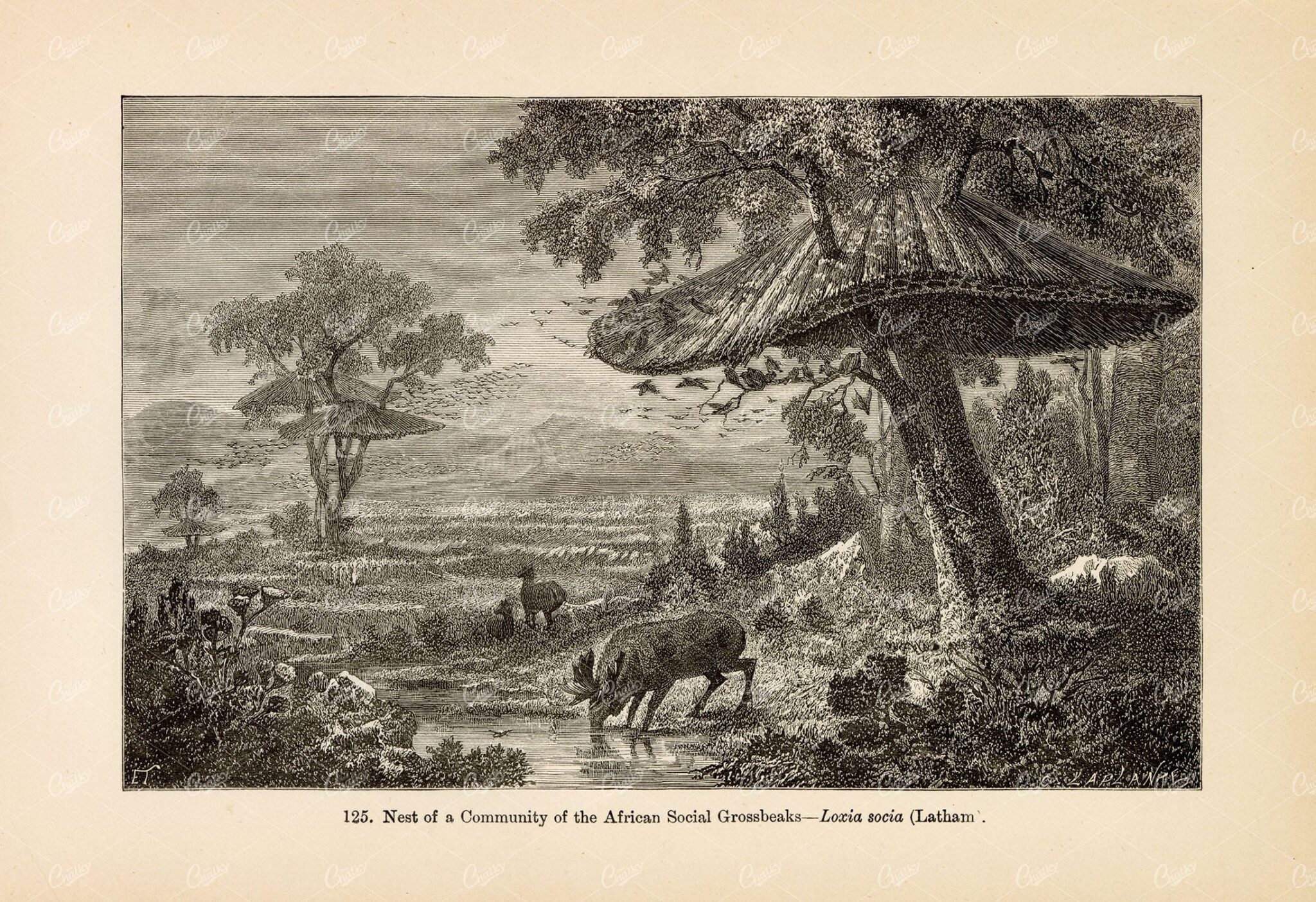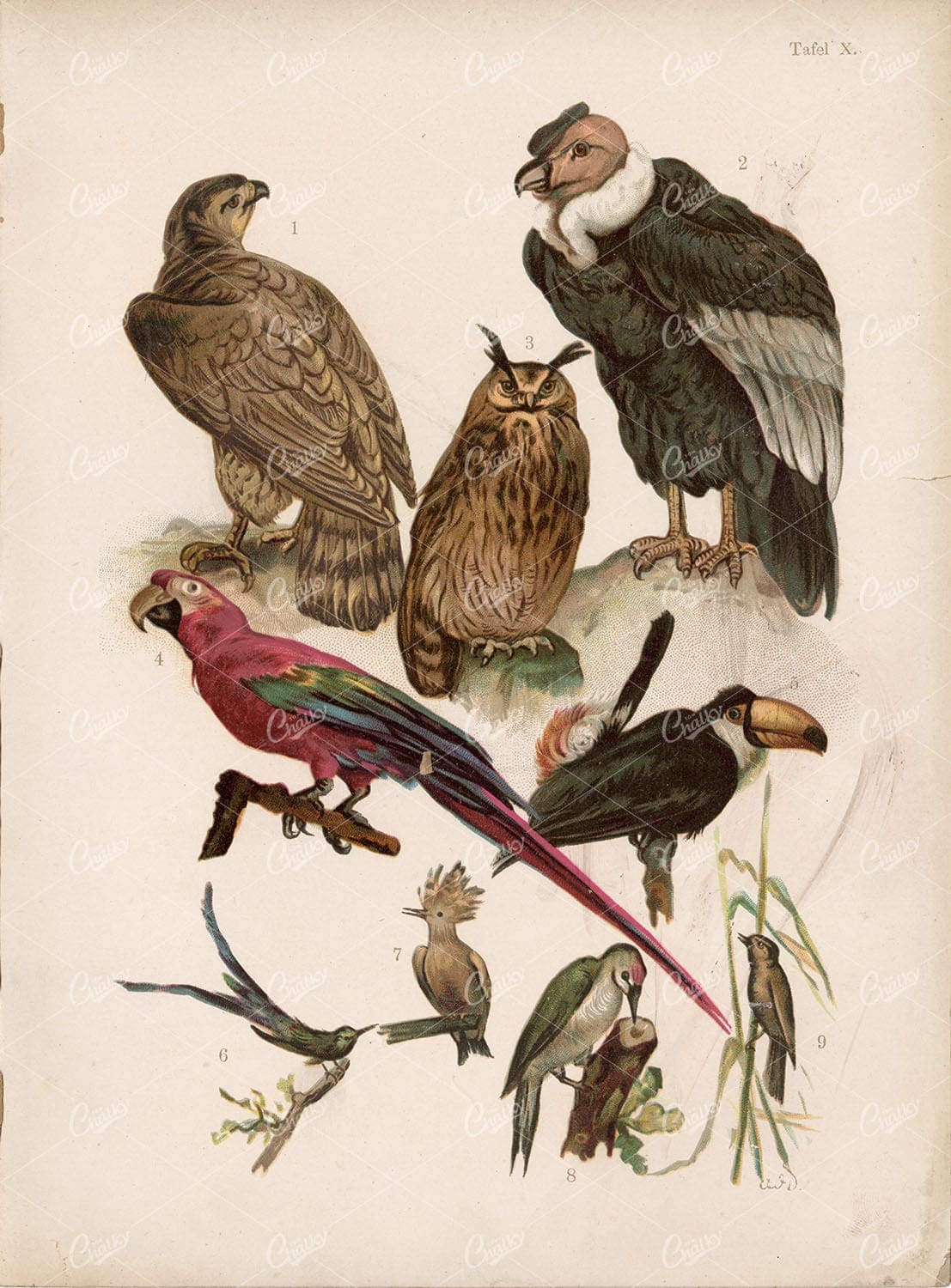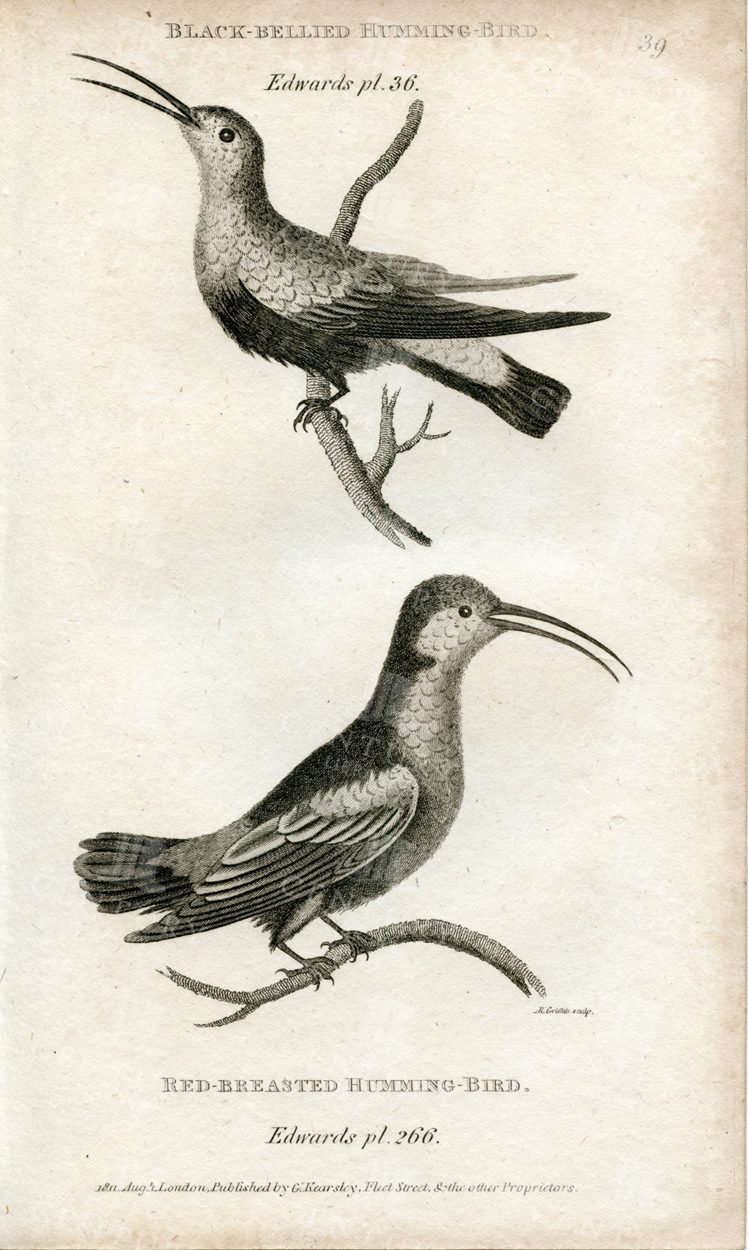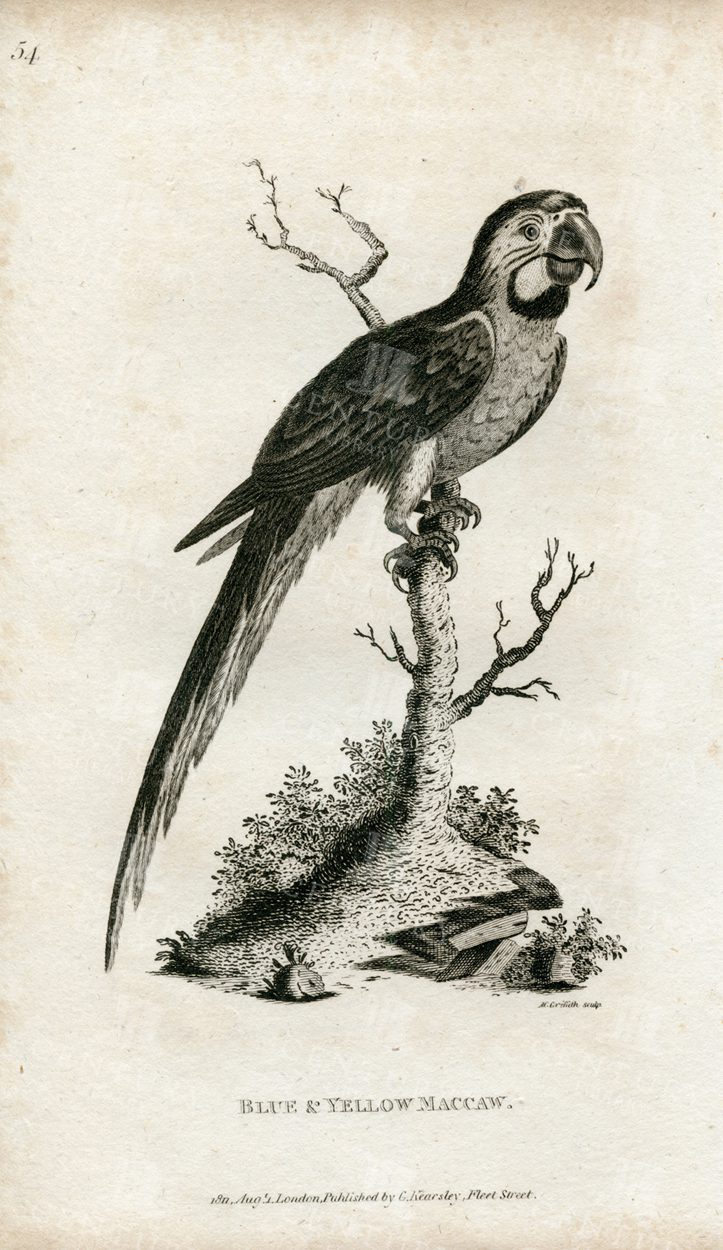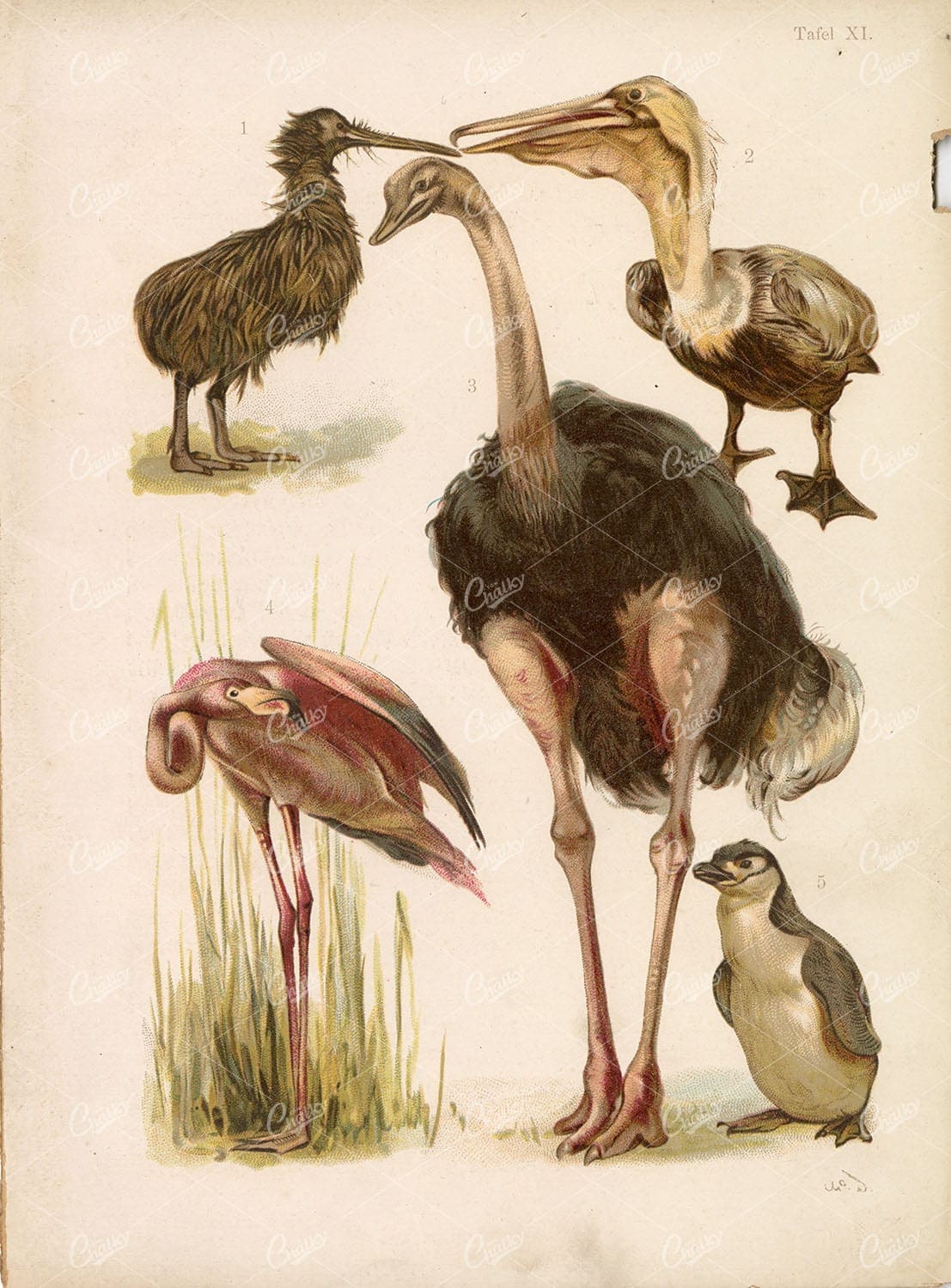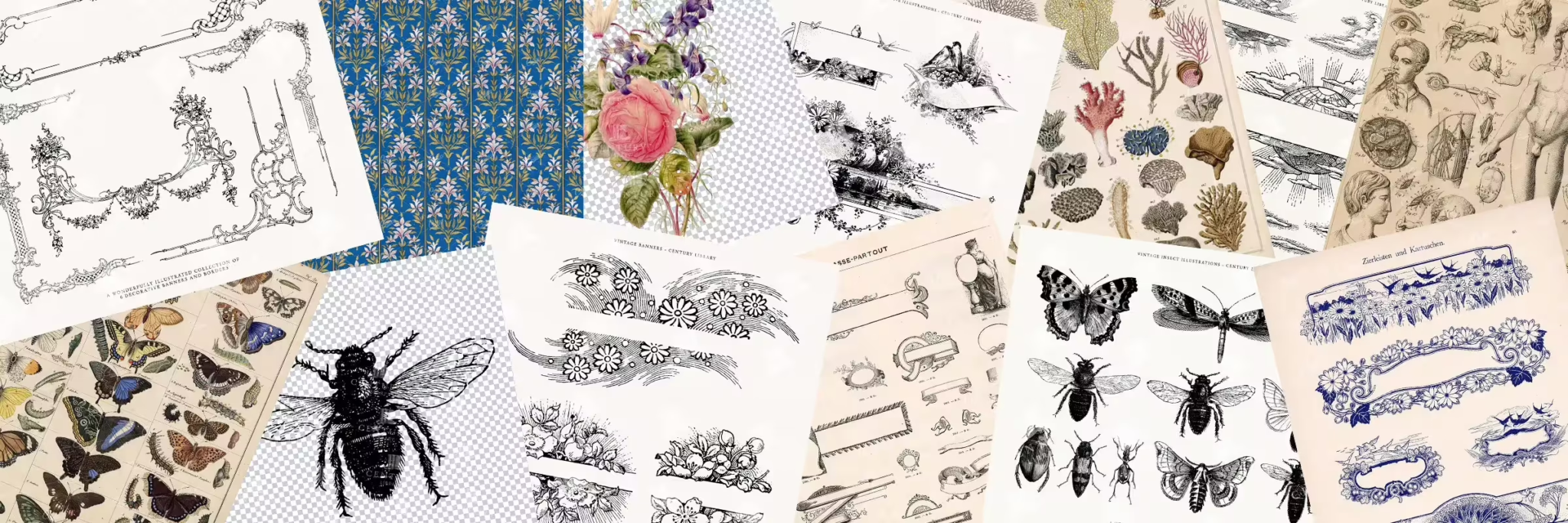


ANTIQUE Original Kono Bairei Woodblock Japanese Print 1881 Bird Flower
You’re looking at a beautiful piece of Japanese woodblock art from our collection of original 1881 prints by noted artist, Kono Bairei; Created for one of his best-known publications ‘one hundred birds’. Most of the bird species throughout this collection were native to Japan, with a few domesticated and some imported cage birds. Bairei was born and lived in Kyoto. He was apprenticed to the Maruyama printer Nakajima Raiso at the age of eight. He was a pupil of Shijo artist Shiokawa Bunrin and followed the Nanga school tradition. He established the Kyoto Prefectural School of Painting before opening his own studio to students and retiring from teaching.
- License Info
- Resolution: 5652 x 8004 300dpi
- Year of Print: 1881
- Artist: Kono Bairei
From this collection
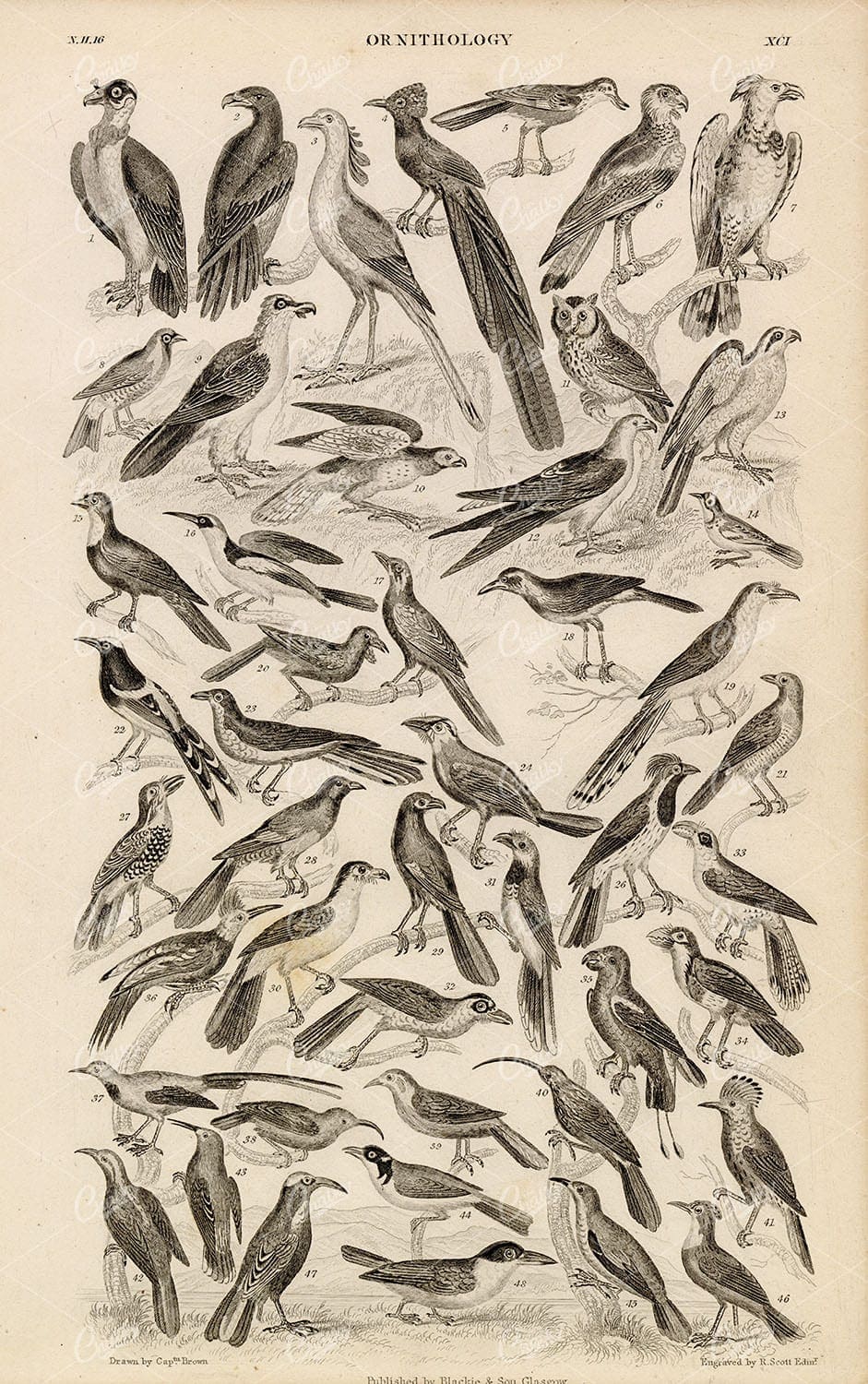

ORIGINAL Antique 1868 Print – Ornithology – Various Bird Species
Here we have a high resolution scan of a wonderful lithograph print from Oliver Goldsmith's "A History of the Earth and Animated Nature". A celebrated series of books from the 1860's, wherein the most distinguished British and Foreign naturalists collaborated to produce.
- License Info
- Resolution: 5379 x 8576 300dpi
- Year of Print: 1868
- Artist: Oliver Goldsmith
From this collection


BIRDS – Trogon, Cuckoos, Anis – Antique Oken’s Naturgeschichte Print
Original Colour Vintage Print from Lorenz Okenfuss' 'Oken's Naturgeschichte' (Allgemeine Naturgeschichte für alle Stände), with illustrations by Johann Susemihl (1767-1847), and published in Stuttgart by Hoffman between 1839 and 1841. Lorenz Oken (1 August 1779 - 11 August 1851) was a German naturalist, botanist, biologist, and ornithologist. Oken was born Lorenz Okenfuss (German: Okenfuß) in Bohlsbach (now part of Offenburg), Ortenau, Baden, and studied natural history and medicine at the universities of Freiburg and Würzburg. He went on to the University of Göttingen, where he became a Privatdozent (unsalaried lecturer), and shortened his name to Oken. As Lorenz Oken, he published a small work entitled Grundriss der Naturphilosophie, der Theorie der Sinne, mit der darauf gegründeten Classification der Thiere (1802). This was the first of a series of works which established him as a leader of the movement of "Naturphilosophie" in Germany.
- License Info
- Resolution: 9300 x 11600 300dpi
- Year of Print: 1836
- Artist: Lorenz Oken
From this collection
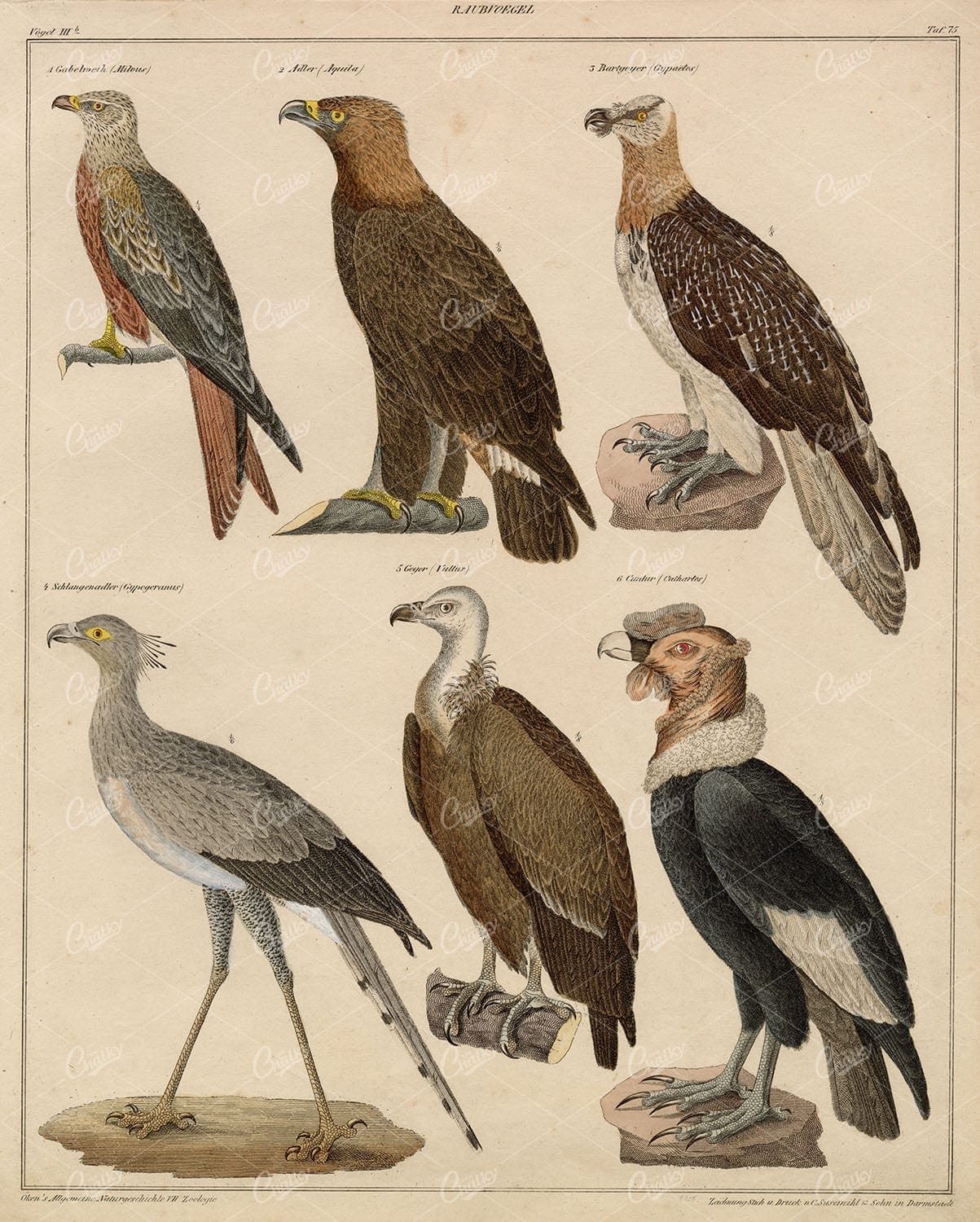

BIRDS of Prey – Eagle, Vulture, Cathartes, Secretarybird – Antique Print
Original Colour Vintage Print from Lorenz Okenfuss' 'Oken's Naturgeschichte' (Allgemeine Naturgeschichte für alle Stände), with illustrations by Johann Susemihl (1767-1847), and published in Stuttgart by Hoffman between 1839 and 1841. Lorenz Oken (1 August 1779 - 11 August 1851) was a German naturalist, botanist, biologist, and ornithologist. Oken was born Lorenz Okenfuss (German: Okenfuß) in Bohlsbach (now part of Offenburg), Ortenau, Baden, and studied natural history and medicine at the universities of Freiburg and Würzburg. He went on to the University of Göttingen, where he became a Privatdozent (unsalaried lecturer), and shortened his name to Oken. As Lorenz Oken, he published a small work entitled Grundriss der Naturphilosophie, der Theorie der Sinne, mit der darauf gegründeten Classification der Thiere (1802). This was the first of a series of works which established him as a leader of the movement of "Naturphilosophie" in Germany.
- License Info
- Resolution: 9300 x 11600 300dpi
- Year of Print: 1836
- Artist: Lorenz Oken
From this collection


Little Crane (Grus Fraterculus, Cassin) 1853 Color Antique Bird Stock Image
This 167 year old scan is from "U.S.P.R.R. Exp. & Surveys - To ascertain the most practicable and economical route for a railroad from the Mississippi River to the Pacific Ocean. Made under the direction of the secretary of war in 1853-1856". The artwork inside was some of the most artistic and accurate prints made of Birds, Mammals, Reptiles and Fish from the American West. Many of the Lithographs were beautifully hand-colored by a group of naturalists and artists who travelled with the expedition surverying the West for the U.S. Pacific Railroad. Search our archives or click on the artist name below to view the rest of the collection!
- License Info
- Resolution: 7594 x 10009 300dpi
- Year of Print: 1853
- Artist: USPRR Surveys
From this collection


STUNNING Vintage Engraving – Red Throated Humming Bird – Vintage Print
- License Info
- Resolution: 4525px x 7616px
- Year of Print: 1812
- Artist: George Shaw Engravings by Mrs Griffith
Related Images


WOODPECKERS – Nuthatch, Jacamar, Kingfisher – Antique Colored Litho
Original Colour Vintage Print from Lorenz Okenfuss' 'Oken's Naturgeschichte' (Allgemeine Naturgeschichte für alle Stände), with illustrations by Johann Susemihl (1767-1847), and published in Stuttgart by Hoffman between 1839 and 1841. Lorenz Oken (1 August 1779 - 11 August 1851) was a German naturalist, botanist, biologist, and ornithologist. Oken was born Lorenz Okenfuss (German: Okenfuß) in Bohlsbach (now part of Offenburg), Ortenau, Baden, and studied natural history and medicine at the universities of Freiburg and Würzburg. He went on to the University of Göttingen, where he became a Privatdozent (unsalaried lecturer), and shortened his name to Oken. As Lorenz Oken, he published a small work entitled Grundriss der Naturphilosophie, der Theorie der Sinne, mit der darauf gegründeten Classification der Thiere (1802). This was the first of a series of works which established him as a leader of the movement of "Naturphilosophie" in Germany.
- License Info
- Resolution: 9300 x 11600 300dpi
- Year of Print: 1836
- Artist: Lorenz Oken
From this collection


ANTIQUE Illustration – Moa, or Gigantic Dinornis and Apteryx – 1877 Print
- License Info
- Resolution: 4841 x 7548 300dpi
- Year of Print: 1877
- Artist: Unknown
Related Images
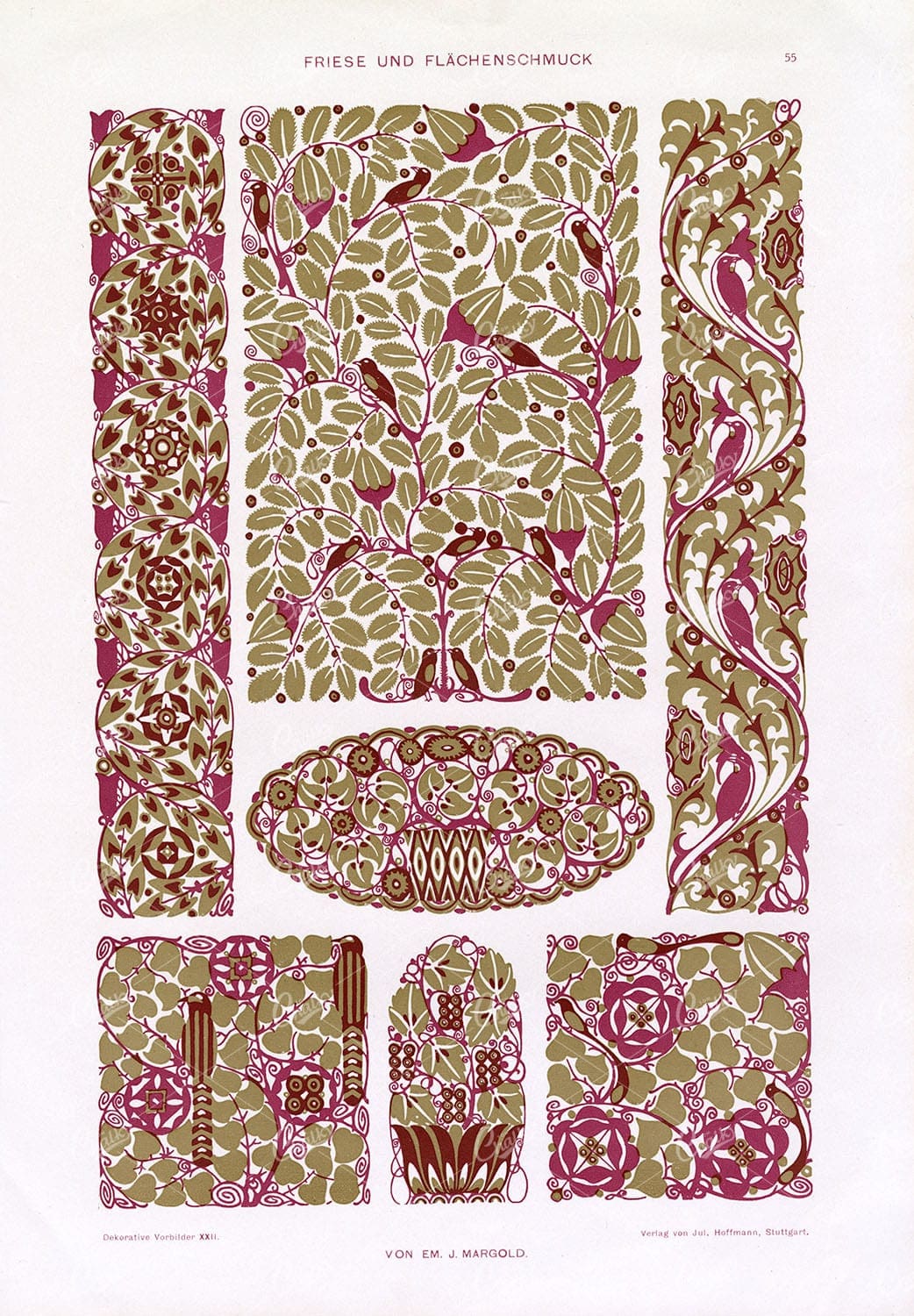

DEKORATIVE Vorbilder XXII, Friese und Flachenschmuck, Friezes Decoration
This image was sourced from our original 'Dekorative Vorbilder' collection; A gorgeous collection of Art Nouveau decorative patterns, graphics and illustrations including plants, figures and animals. For draftsman, painters, graphic artists, decorators, sculptors and architects. Published in 1904 by Julius Hoffman, Stuttgart.
- License Info
- Resolution: 11206 x 16331 300dpi
- Year of Print: 1904
- Artist: Julius Hoffman
From this collection


1904 Vintage Natural History Print – White-Tailed Sea-Eagles
- License Info
- Resolution: 5228px x 7870px
- Year of Print: 1904
- Artist: J. R. Ainsworth Davis
Related Images


ANTIQUE Original Kono Bairei Woodblock Japanese Print 1881 Bird
You’re looking at a beautiful piece of Japanese woodblock art from our collection of original 1881 prints by noted artist, Kono Bairei; Created for one of his best-known publications ‘one hundred birds’. Most of the bird species throughout this collection were native to Japan, with a few domesticated and some imported cage birds. Bairei was born and lived in Kyoto. He was apprenticed to the Maruyama printer Nakajima Raiso at the age of eight. He was a pupil of Shijo artist Shiokawa Bunrin and followed the Nanga school tradition. He established the Kyoto Prefectural School of Painting before opening his own studio to students and retiring from teaching.
- License Info
- Resolution: 5656 x 7906 300dpi
- Year of Print: 1881
- Artist: Kono Bairei
From this collection
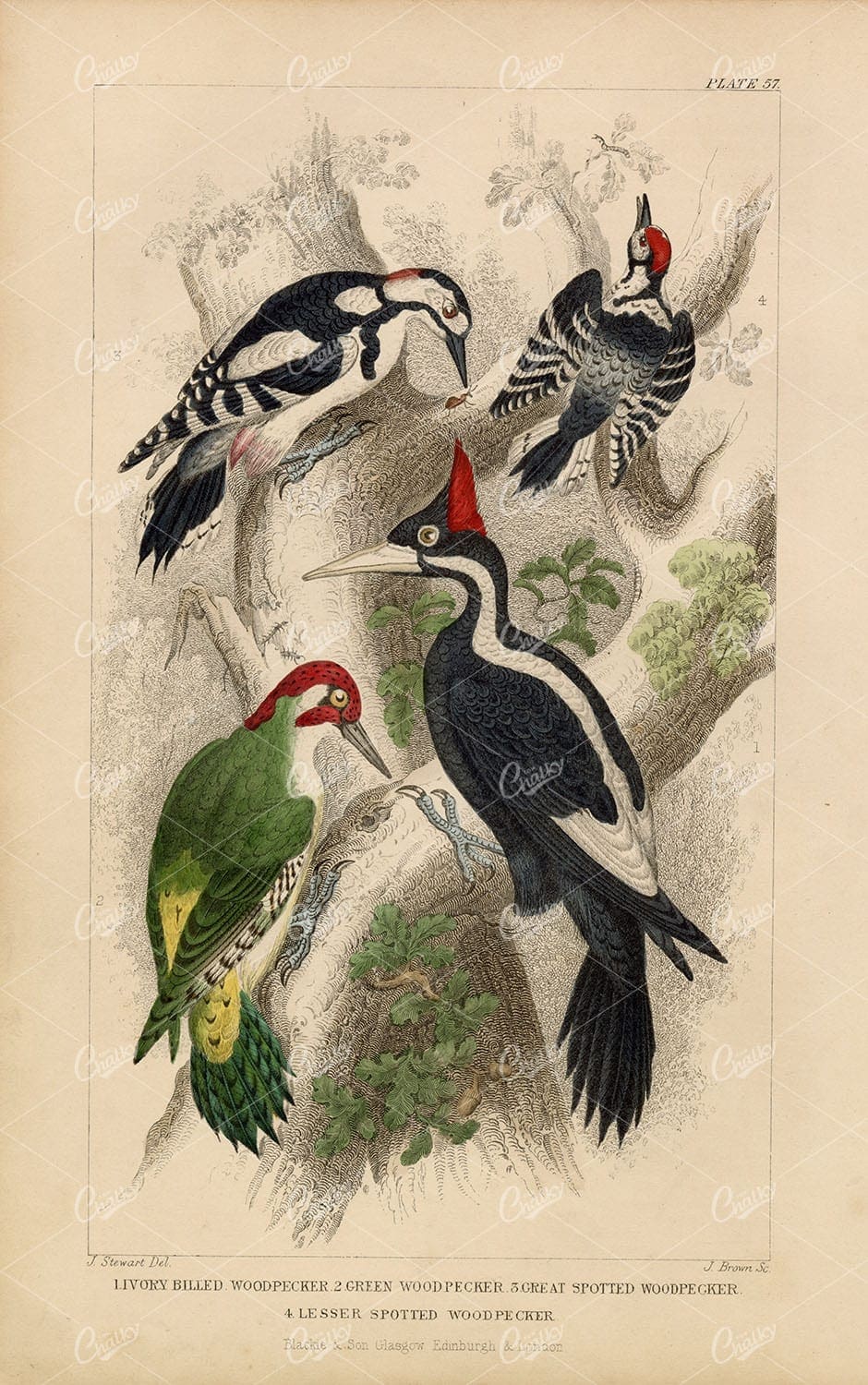

ANTIQUE Handcolored Print of Various Woodpecker Species – J. Stewart
Here we have a high resolution scan of a wonderfully handcoloured lithograph print from Oliver Goldsmith's "A History of the Earth and Animated Nature". A celebrated series of books from the 1860's, wherein the most distinguished British and Foreign naturalists collaborated to produce.
- License Info
- Resolution: 5386 x 8594 300dpi
- Year of Print: 1868
- Artist: Oliver Goldsmith
From this collection


ANTIQUE 1807 Rural Sports Engraving – A Black Swan
- License Info
- Resolution: 8061px x 4824px
- Year of Print: 1807
Related Images
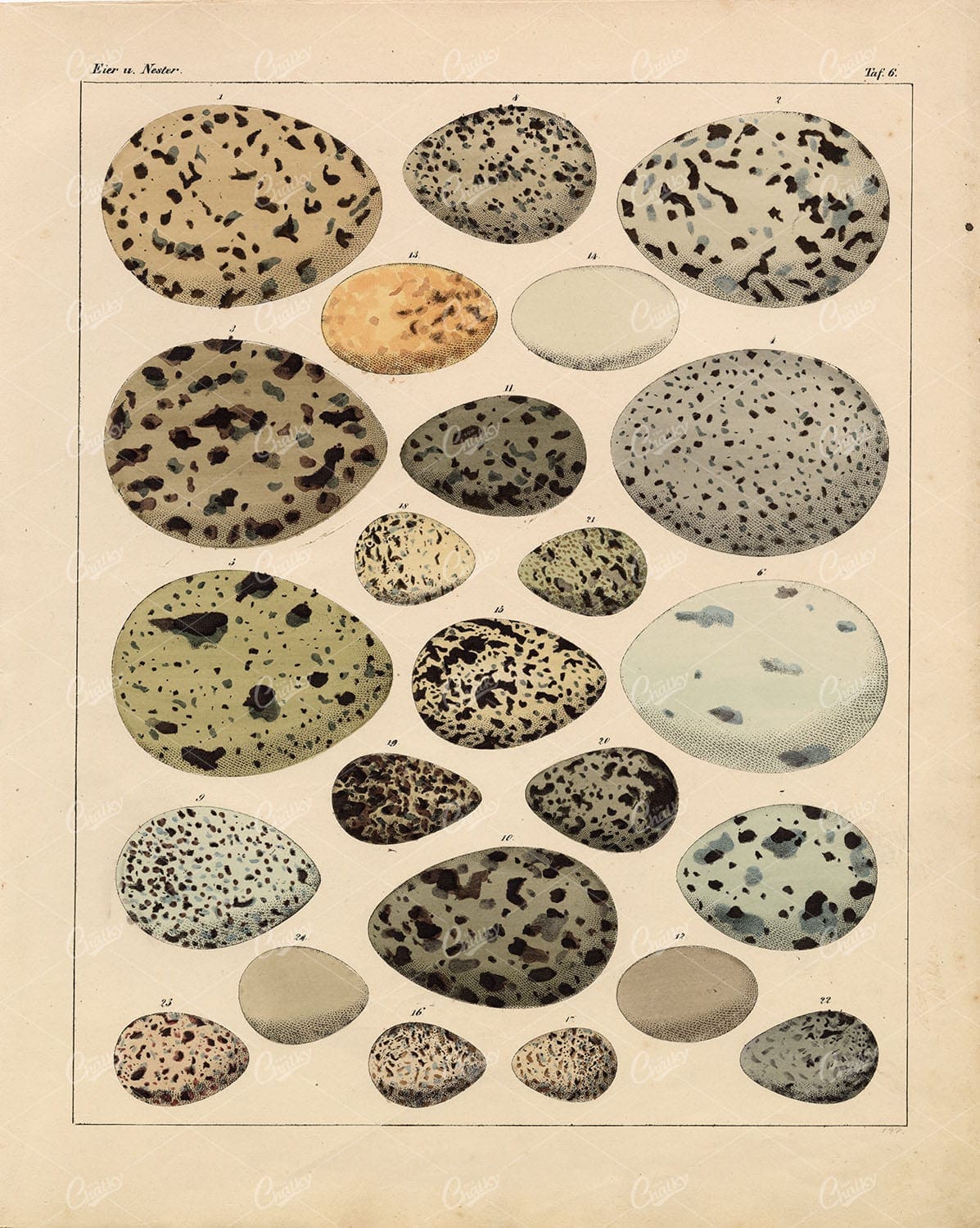

EGGS – Variety of Bird Eggs – Oken’s Naturgeschichte Vintage Artwork
Original Colour Vintage Print from Lorenz Okenfuss' 'Oken's Naturgeschichte' (Allgemeine Naturgeschichte für alle Stände), with illustrations by Johann Susemihl (1767-1847), and published in Stuttgart by Hoffman between 1839 and 1841. Lorenz Oken (1 August 1779 - 11 August 1851) was a German naturalist, botanist, biologist, and ornithologist. Oken was born Lorenz Okenfuss (German: Okenfuß) in Bohlsbach (now part of Offenburg), Ortenau, Baden, and studied natural history and medicine at the universities of Freiburg and Würzburg. He went on to the University of Göttingen, where he became a Privatdozent (unsalaried lecturer), and shortened his name to Oken. As Lorenz Oken, he published a small work entitled Grundriss der Naturphilosophie, der Theorie der Sinne, mit der darauf gegründeten Classification der Thiere (1802). This was the first of a series of works which established him as a leader of the movement of "Naturphilosophie" in Germany.
- License Info
- Resolution: 9300 x 11600 300dpi
- Year of Print: 1836
- Artist: Lorenz Oken
From this collection
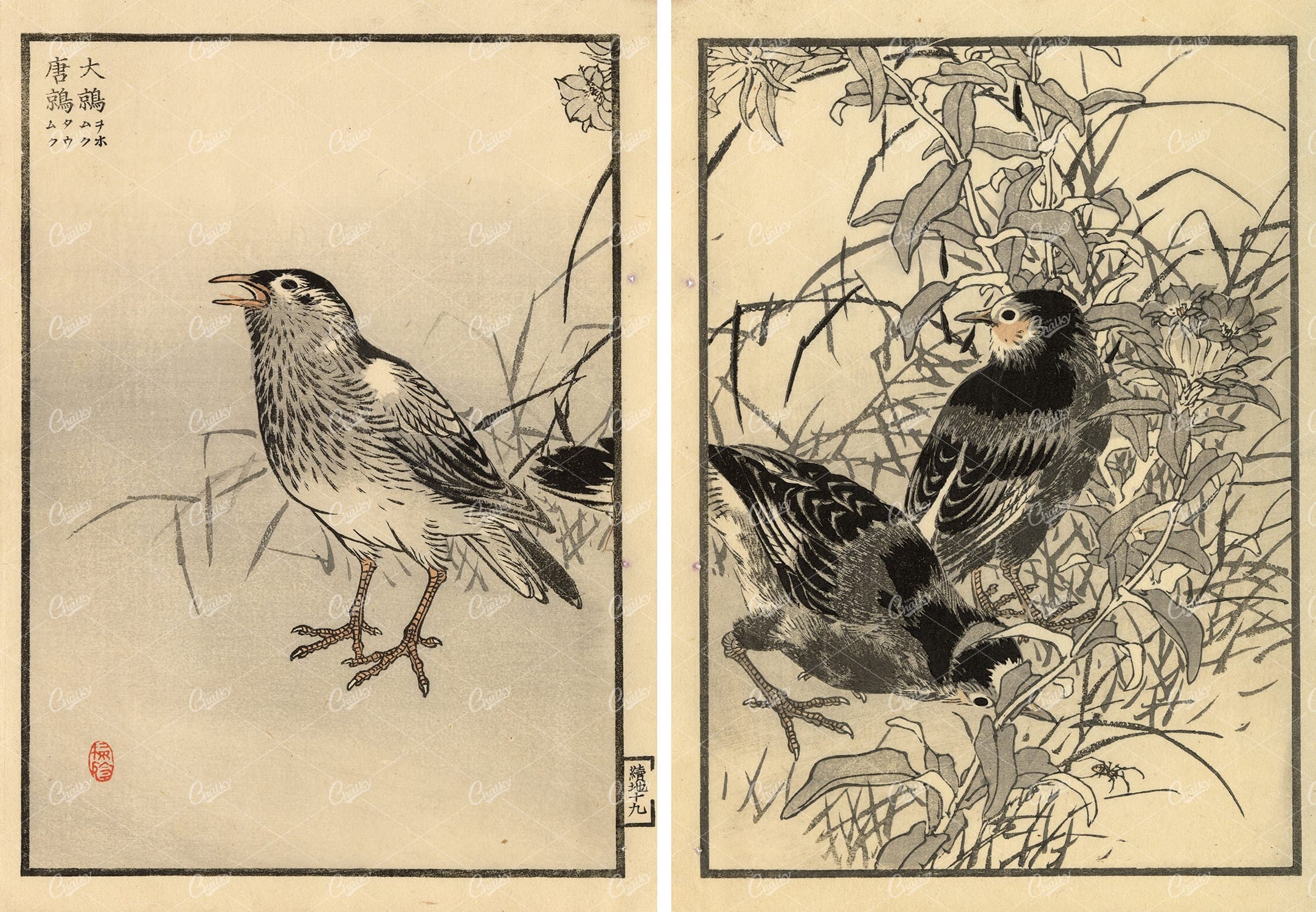

ANTIQUE Original Kono Bairei Woodblock Japanese Prints 1881 Birds
You’re looking at a beautiful piece of Japanese woodblock art from our collection of original 1881 prints by noted artist, Kono Bairei; Created for one of his best-known publications ‘one hundred birds’. Most of the bird species throughout this collection were native to Japan, with a few domesticated and some imported cage birds. Bairei was born and lived in Kyoto. He was apprenticed to the Maruyama printer Nakajima Raiso at the age of eight. He was a pupil of Shijo artist Shiokawa Bunrin and followed the Nanga school tradition. He established the Kyoto Prefectural School of Painting before opening his own studio to students and retiring from teaching.
- License Info
- Resolution: 11582 x 8028
- Year of Print: 1881
- Artist: Kono Bairei
From this collection


EGGS – Variety of Bird Eggs – Oken’s Naturgeschichte Handcolored Litho
Original Colour Vintage Print from Lorenz Okenfuss' 'Oken's Naturgeschichte' (Allgemeine Naturgeschichte für alle Stände), with illustrations by Johann Susemihl (1767-1847), and published in Stuttgart by Hoffman between 1839 and 1841. Lorenz Oken (1 August 1779 - 11 August 1851) was a German naturalist, botanist, biologist, and ornithologist. Oken was born Lorenz Okenfuss (German: Okenfuß) in Bohlsbach (now part of Offenburg), Ortenau, Baden, and studied natural history and medicine at the universities of Freiburg and Würzburg. He went on to the University of Göttingen, where he became a Privatdozent (unsalaried lecturer), and shortened his name to Oken. As Lorenz Oken, he published a small work entitled Grundriss der Naturphilosophie, der Theorie der Sinne, mit der darauf gegründeten Classification der Thiere (1802). This was the first of a series of works which established him as a leader of the movement of "Naturphilosophie" in Germany.
- License Info
- Resolution: 9300 x 11600 300dpi
- Year of Print: 1836
- Artist: Lorenz Oken
From this collection
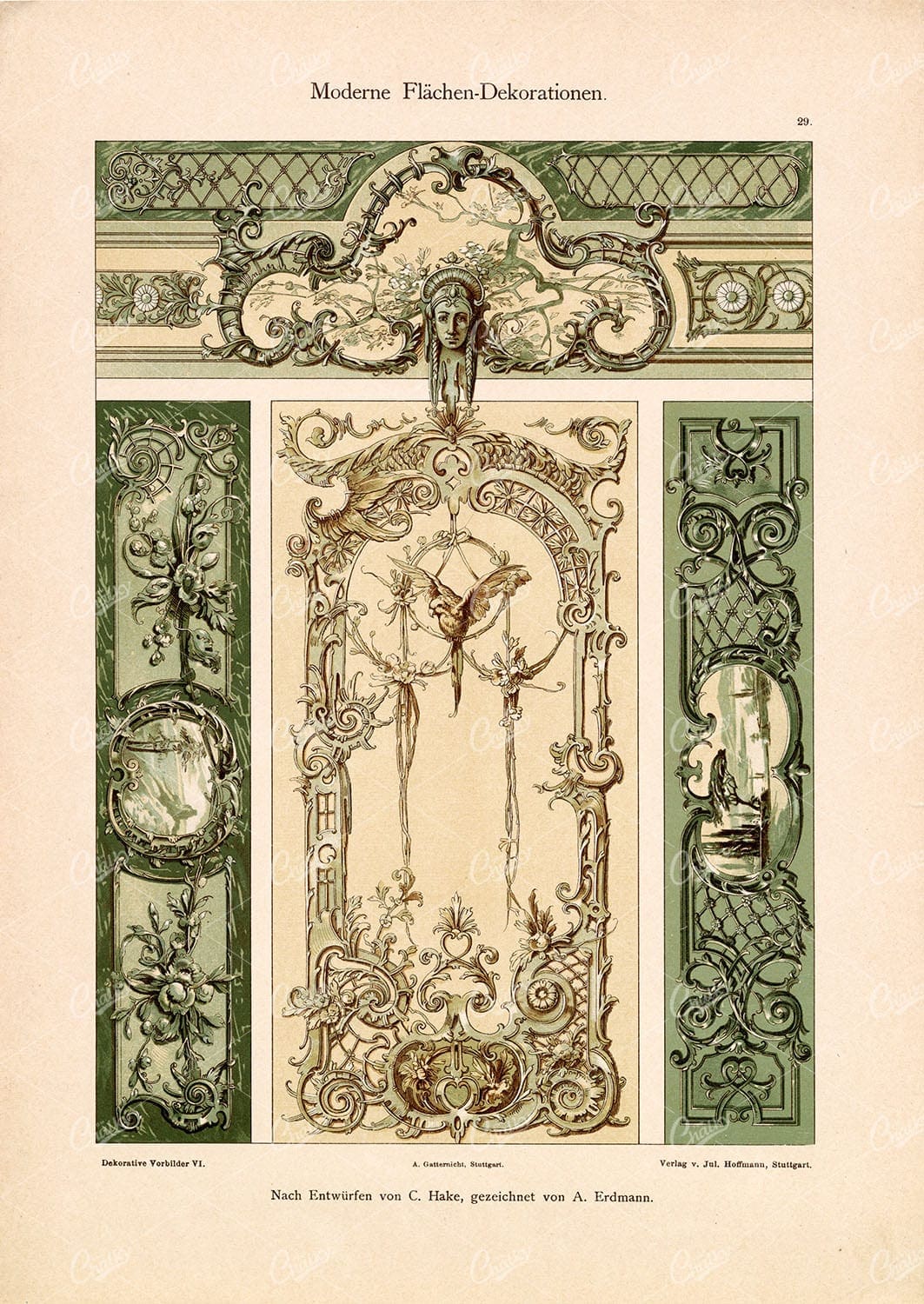

DEKORATIVE Vorbilder VI, Moderne Flachen-Dekorationen, Ornate Design
This image was sourced from our original 'Dekorative Vorbilder' collection; A gorgeous collection of Art Nouveau decorative patterns, graphics and illustrations including plants, figures and animals. For draftsman, painters, graphic artists, decorators, sculptors and architects. Published in 1904 by Julius Hoffman, Stuttgart.
- License Info
- Resolution: 10570 x 14995 300dpi
- Year of Print: 1904
- Artist: Julius Hoffman
From this collection
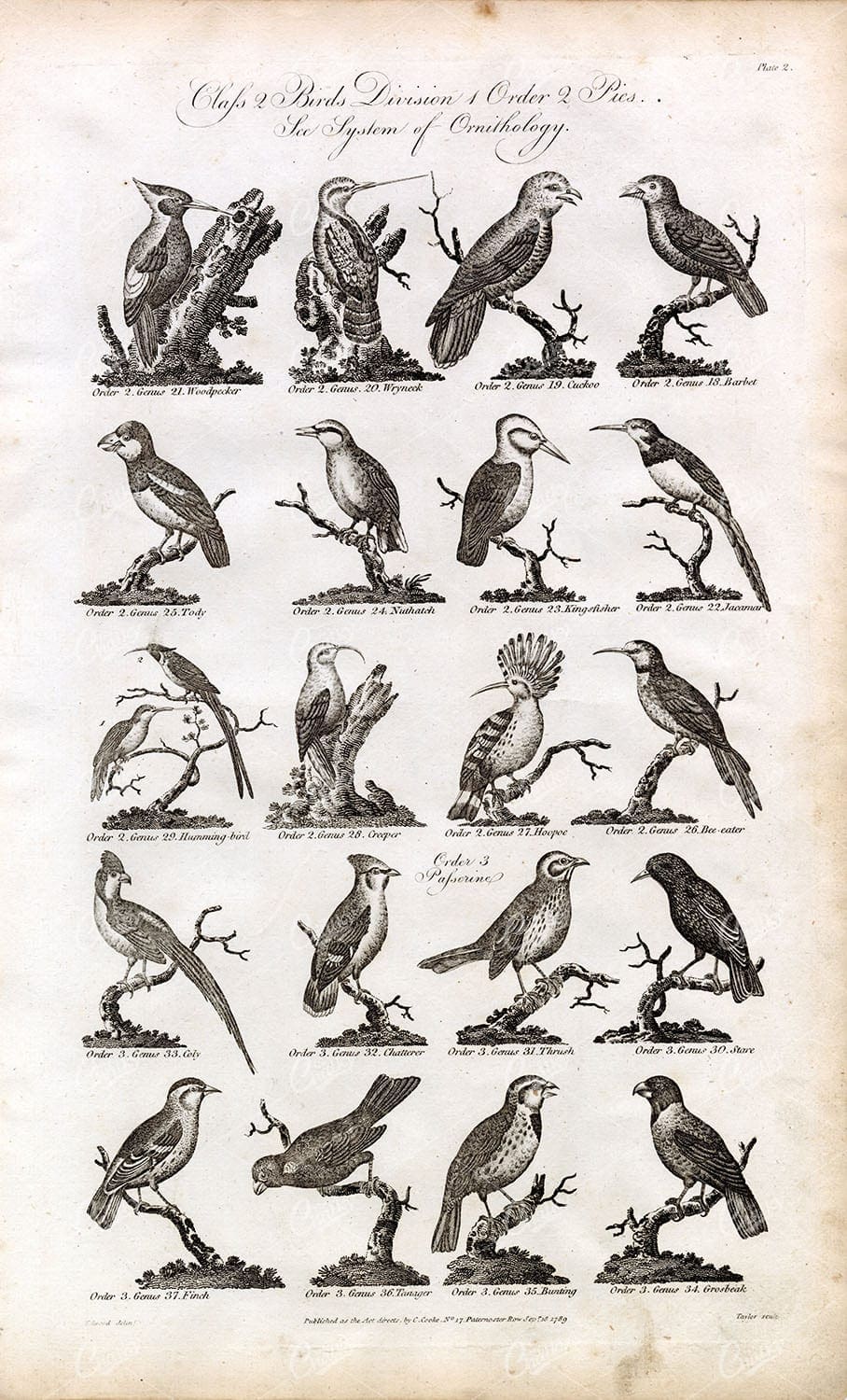

BIRDS Engraving – Woodpecker, Kingfisher, Jacamar, Humming-Bird – 1791
You're looking at a scarce, 229 year old, steel plate engraving from the original "The New Encyclopaedia Or Modern Universal Dictionary Of Arts And Sciences On A New And Improved Plan" by Hall, William Henry, Bedford Row, London, published by C Cooke, London.
- License Info
- Resolution: 8300 x 13800 300dpi
- Year of Print: 1791
- Artist: C. Cooke
Related Images
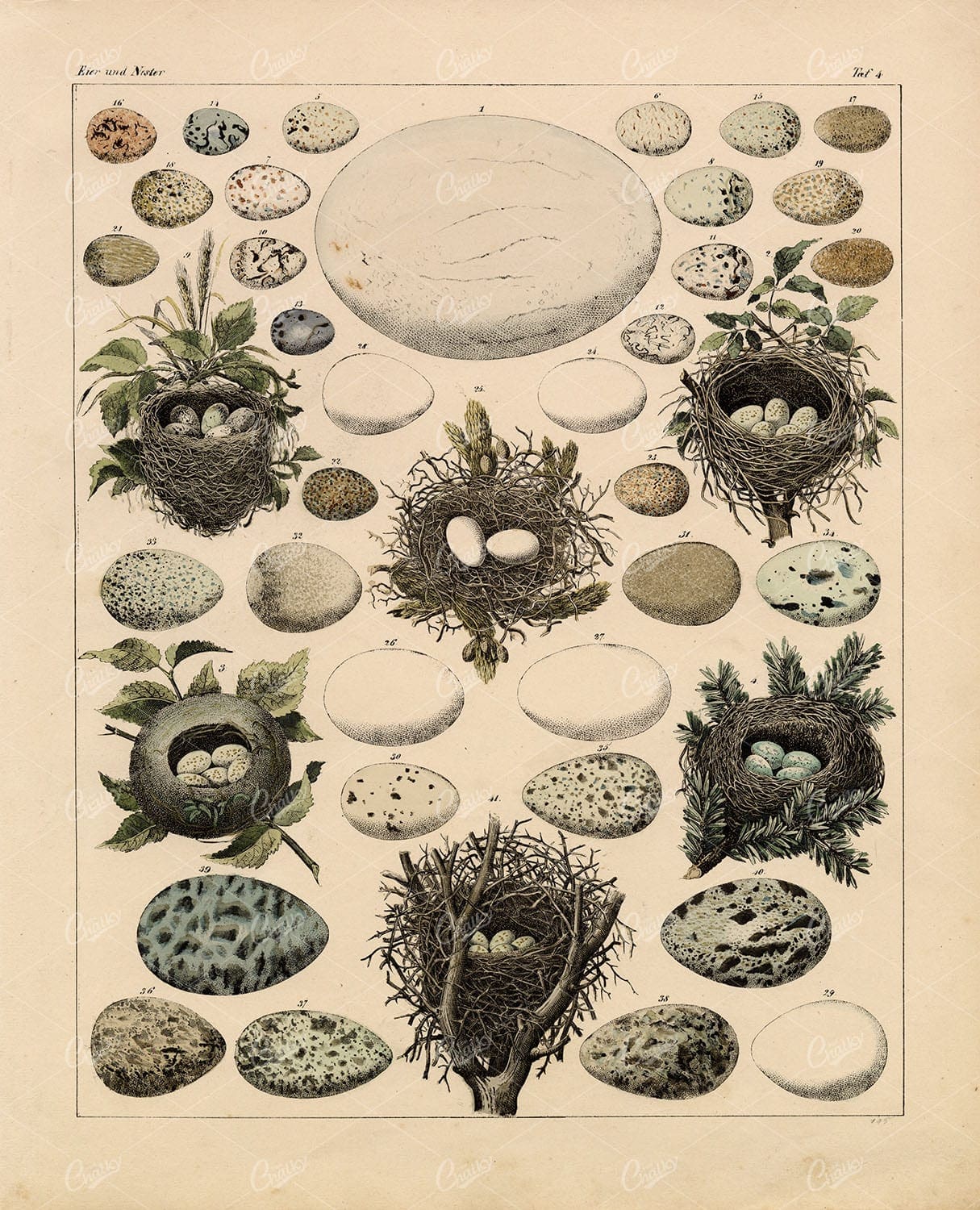

EGGS – Variety of Bird Eggs – Oken’s Naturgeschichte Antique Artwork
Original Colour Vintage Print from Lorenz Okenfuss' 'Oken's Naturgeschichte' (Allgemeine Naturgeschichte für alle Stände), with illustrations by Johann Susemihl (1767-1847), and published in Stuttgart by Hoffman between 1839 and 1841. Lorenz Oken (1 August 1779 - 11 August 1851) was a German naturalist, botanist, biologist, and ornithologist. Oken was born Lorenz Okenfuss (German: Okenfuß) in Bohlsbach (now part of Offenburg), Ortenau, Baden, and studied natural history and medicine at the universities of Freiburg and Würzburg. He went on to the University of Göttingen, where he became a Privatdozent (unsalaried lecturer), and shortened his name to Oken. As Lorenz Oken, he published a small work entitled Grundriss der Naturphilosophie, der Theorie der Sinne, mit der darauf gegründeten Classification der Thiere (1802). This was the first of a series of works which established him as a leader of the movement of "Naturphilosophie" in Germany.
- License Info
- Resolution: 9300 x 11600 300dpi
- Year of Print: 1836
- Artist: Lorenz Oken
From this collection


ANTIQUE Original Kono Bairei Woodblock Japanese Prints 1881 Birds
You’re looking at a beautiful piece of Japanese woodblock art from our collection of original 1881 prints by noted artist, Kono Bairei; Created for one of his best-known publications ‘one hundred birds’. Most of the bird species throughout this collection were native to Japan, with a few domesticated and some imported cage birds. Bairei was born and lived in Kyoto. He was apprenticed to the Maruyama printer Nakajima Raiso at the age of eight. He was a pupil of Shijo artist Shiokawa Bunrin and followed the Nanga school tradition. He established the Kyoto Prefectural School of Painting before opening his own studio to students and retiring from teaching.
- License Info
- Resolution: 11582 x 8028
- Year of Print: 1881
- Artist: Kono Bairei
From this collection


ORIGINAL Antique 1868 Print – Ornithology – Dodo, Crane, Gull, Toucan
Here we have a high resolution scan of a wonderful lithograph print from Oliver Goldsmith's "A History of the Earth and Animated Nature". A celebrated series of books from the 1860's, wherein the most distinguished British and Foreign naturalists collaborated to produce.
- License Info
- Resolution: 5362 x 8559 300dpi
- Year of Print: 1868
- Artist: Oliver Goldsmith
From this collection
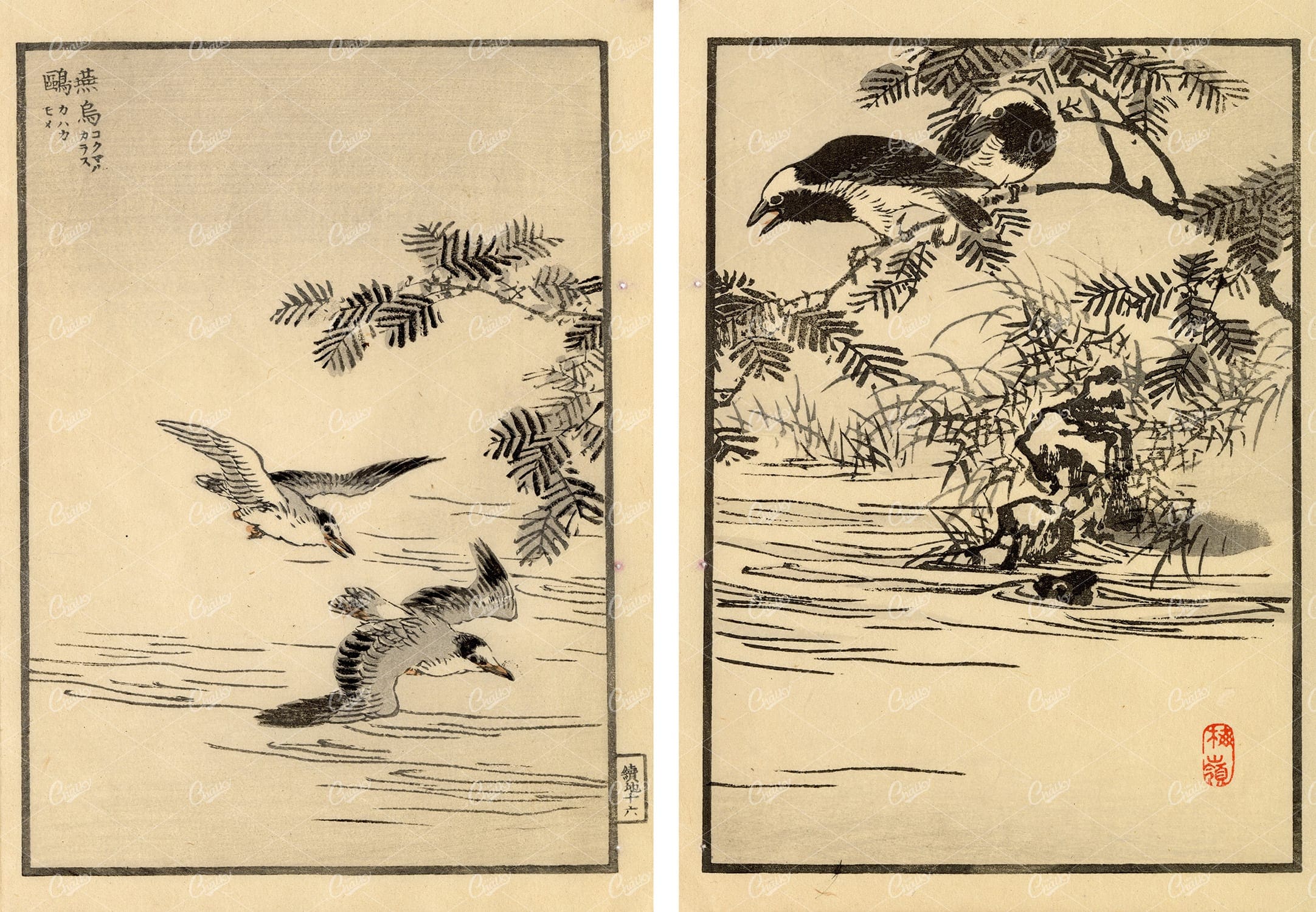

ANTIQUE Original Kono Bairei Woodblock Japanese Prints 1881 Birds
You’re looking at a beautiful piece of Japanese woodblock art from our collection of original 1881 prints by noted artist, Kono Bairei; Created for one of his best-known publications ‘one hundred birds’. Most of the bird species throughout this collection were native to Japan, with a few domesticated and some imported cage birds. Bairei was born and lived in Kyoto. He was apprenticed to the Maruyama printer Nakajima Raiso at the age of eight. He was a pupil of Shijo artist Shiokawa Bunrin and followed the Nanga school tradition. He established the Kyoto Prefectural School of Painting before opening his own studio to students and retiring from teaching.
- License Info
- Resolution: 11582 x 8028
- Year of Print: 1881
- Artist: Kono Bairei
From this collection
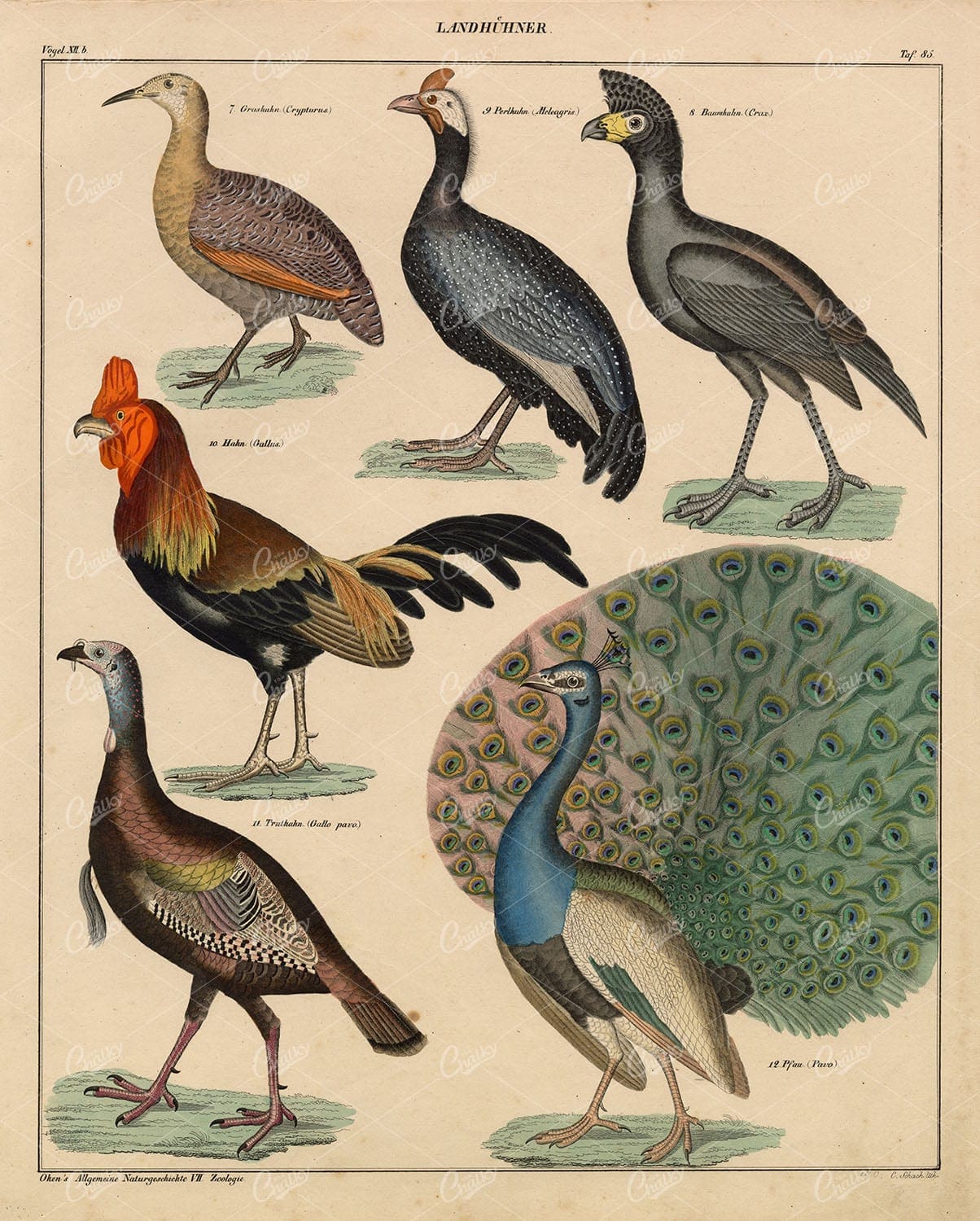

BIRDS – Peacock, Junglefowl, Wild Turkey, Crax – Antique Artwork
Original Colour Vintage Print from Lorenz Okenfuss' 'Oken's Naturgeschichte' (Allgemeine Naturgeschichte für alle Stände), with illustrations by Johann Susemihl (1767-1847), and published in Stuttgart by Hoffman between 1839 and 1841. Lorenz Oken (1 August 1779 - 11 August 1851) was a German naturalist, botanist, biologist, and ornithologist. Oken was born Lorenz Okenfuss (German: Okenfuß) in Bohlsbach (now part of Offenburg), Ortenau, Baden, and studied natural history and medicine at the universities of Freiburg and Würzburg. He went on to the University of Göttingen, where he became a Privatdozent (unsalaried lecturer), and shortened his name to Oken. As Lorenz Oken, he published a small work entitled Grundriss der Naturphilosophie, der Theorie der Sinne, mit der darauf gegründeten Classification der Thiere (1802). This was the first of a series of works which established him as a leader of the movement of "Naturphilosophie" in Germany.
- License Info
- Resolution: 9300 x 11600 300dpi
- Year of Print: 1836
- Artist: Lorenz Oken
From this collection
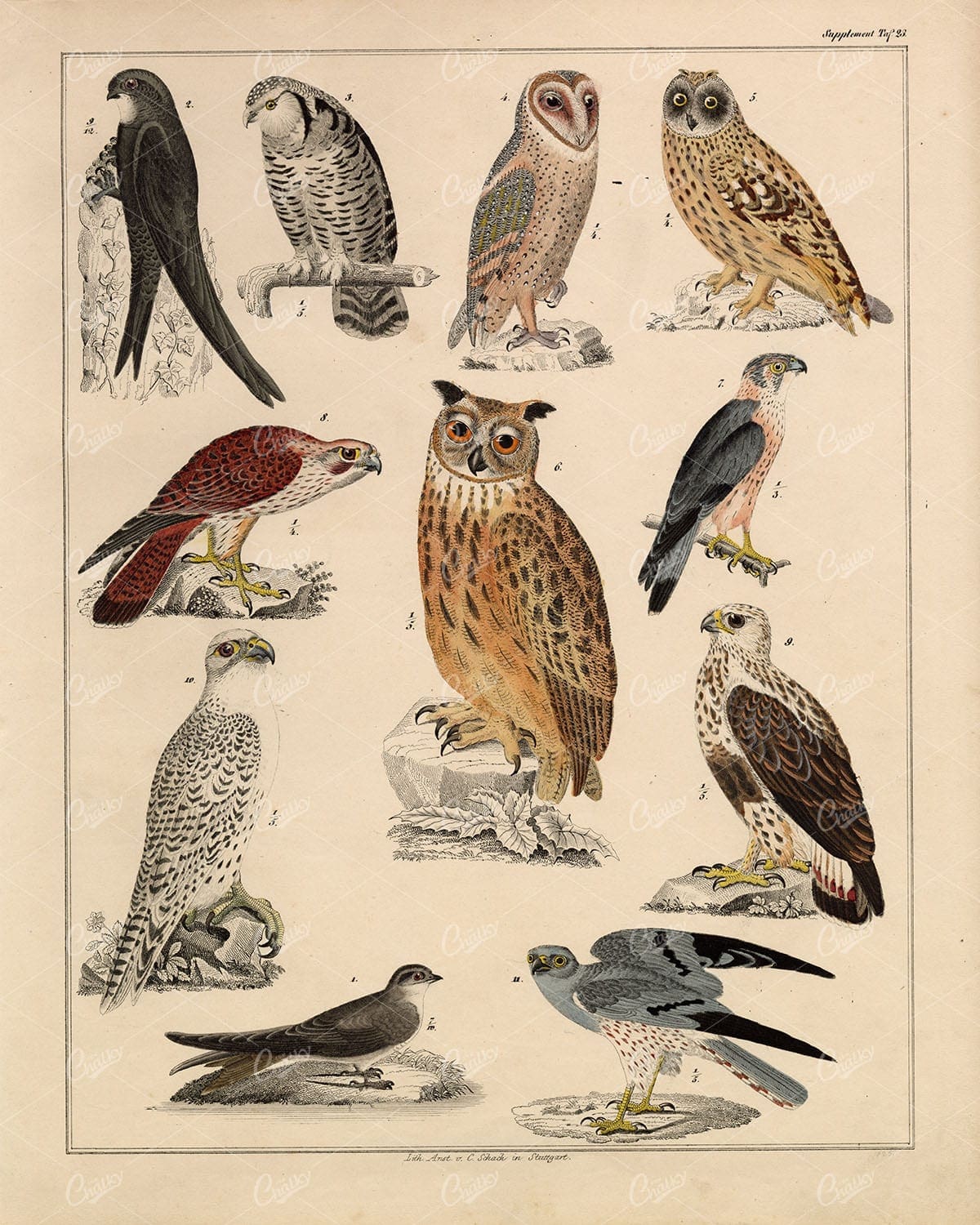

BIRDS – Swift, Owls, Gyrfalcon, Peregrine Falcon – Antique Print
Original Colour Vintage Print from Lorenz Okenfuss' 'Oken's Naturgeschichte' (Allgemeine Naturgeschichte für alle Stände), with illustrations by Johann Susemihl (1767-1847), and published in Stuttgart by Hoffman between 1839 and 1841. Lorenz Oken (1 August 1779 - 11 August 1851) was a German naturalist, botanist, biologist, and ornithologist. Oken was born Lorenz Okenfuss (German: Okenfuß) in Bohlsbach (now part of Offenburg), Ortenau, Baden, and studied natural history and medicine at the universities of Freiburg and Würzburg. He went on to the University of Göttingen, where he became a Privatdozent (unsalaried lecturer), and shortened his name to Oken. As Lorenz Oken, he published a small work entitled Grundriss der Naturphilosophie, der Theorie der Sinne, mit der darauf gegründeten Classification der Thiere (1802). This was the first of a series of works which established him as a leader of the movement of "Naturphilosophie" in Germany.
- License Info
- Resolution: 9300 x 11600 300dpi
- Year of Print: 1836
- Artist: Lorenz Oken
From this collection


BIRDS – Swallows, Banded Broadbill, Nightjar – Antique Colored Lithography
Original Colour Vintage Print from Lorenz Okenfuss' 'Oken's Naturgeschichte' (Allgemeine Naturgeschichte für alle Stände), with illustrations by Johann Susemihl (1767-1847), and published in Stuttgart by Hoffman between 1839 and 1841. Lorenz Oken (1 August 1779 - 11 August 1851) was a German naturalist, botanist, biologist, and ornithologist. Oken was born Lorenz Okenfuss (German: Okenfuß) in Bohlsbach (now part of Offenburg), Ortenau, Baden, and studied natural history and medicine at the universities of Freiburg and Würzburg. He went on to the University of Göttingen, where he became a Privatdozent (unsalaried lecturer), and shortened his name to Oken. As Lorenz Oken, he published a small work entitled Grundriss der Naturphilosophie, der Theorie der Sinne, mit der darauf gegründeten Classification der Thiere (1802). This was the first of a series of works which established him as a leader of the movement of "Naturphilosophie" in Germany.
- License Info
- Resolution: 9300 x 11600 300dpi
- Year of Print: 1836
- Artist: Lorenz Oken
From this collection
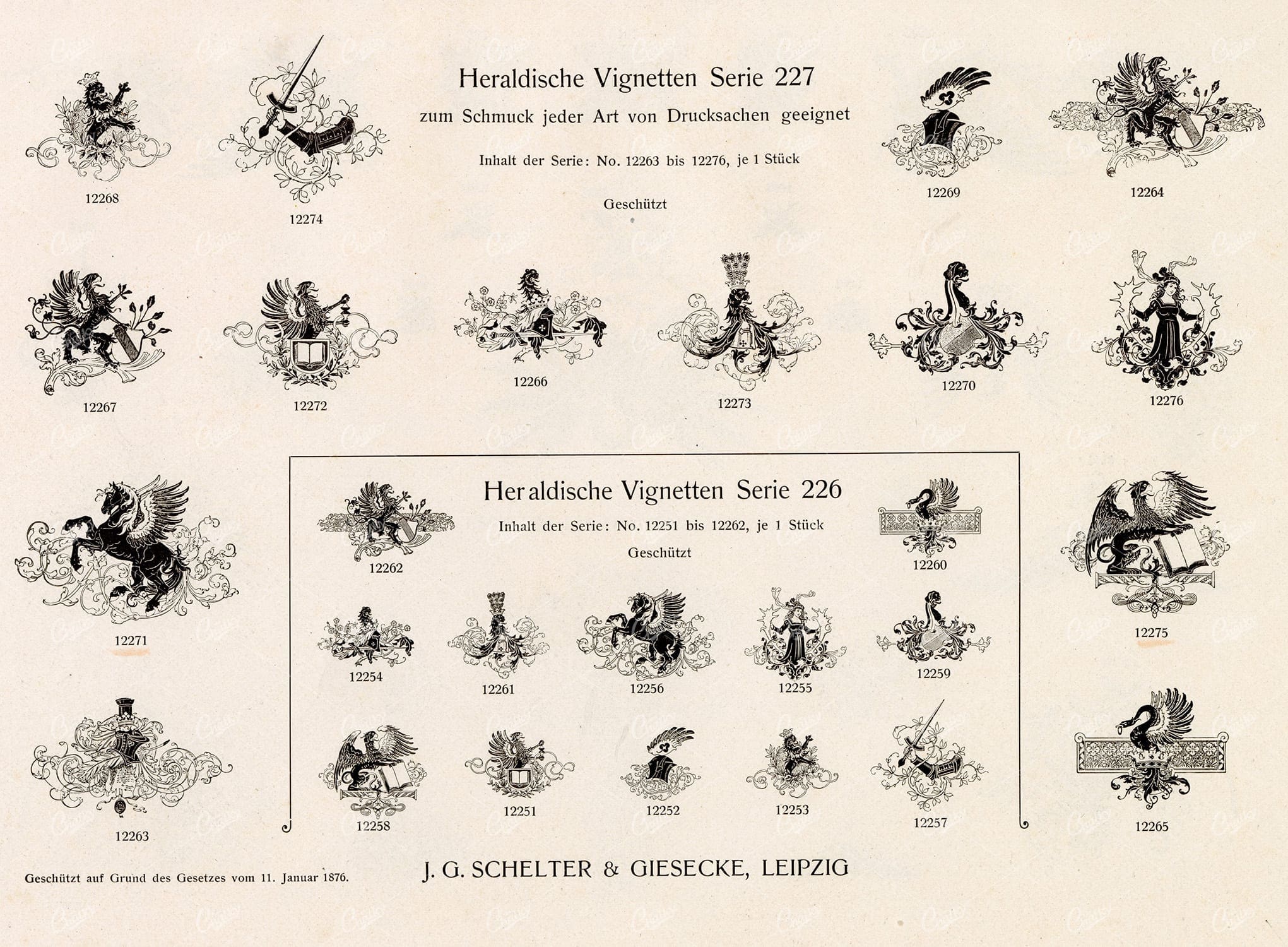

MISCELLANEOUS Selection of Vintage Design Elements – 1800s Antique Stock Artwork
The type foundry and print shop of old would create books, like the one this image was discovered within, to help customers and clients with their design choices. Naturally, these books were jam packed with useful illustrative elements that could be combined to create a final piece. Today, these books are extremely difficult to get a hold of. Especially those that were published in the late 1800s. They were not mainstream publications, they simply served as 'catalogs' and thus were only produced in small numbers. Fortunately, we were introduced to a collector who had precisely what we had been searching for for so long. After some costly negotiations, we're very excited to be able to share the wonderful gems within.
- License Info
- Resolution: 7578 x 5570
- Year of Print: Late 1800s
- Artist: Schelter & Giesecke Type Foundry
From this collection
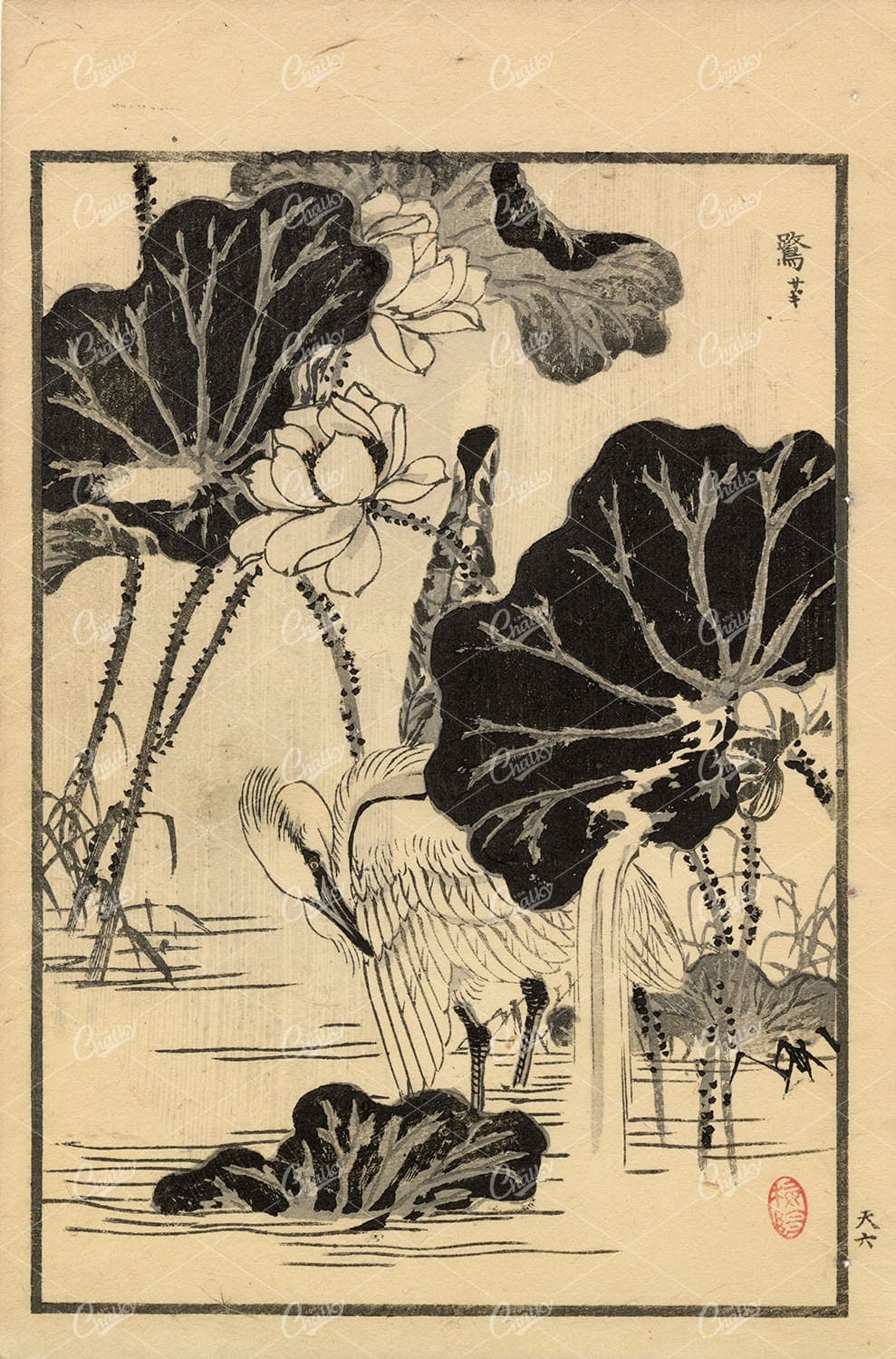

ANTIQUE Original Kono Bairei Woodblock Japanese Print 1881 Bird
You’re looking at a beautiful piece of Japanese woodblock art from our collection of original 1881 prints by noted artist, Kono Bairei; Created for one of his best-known publications ‘one hundred birds’. Most of the bird species throughout this collection were native to Japan, with a few domesticated and some imported cage birds. Bairei was born and lived in Kyoto. He was apprenticed to the Maruyama printer Nakajima Raiso at the age of eight. He was a pupil of Shijo artist Shiokawa Bunrin and followed the Nanga school tradition. He established the Kyoto Prefectural School of Painting before opening his own studio to students and retiring from teaching.
- License Info
- Resolution: 5761 x 8738 300dpi
- Year of Print: 1881
- Artist: Kono Bairei
From this collection
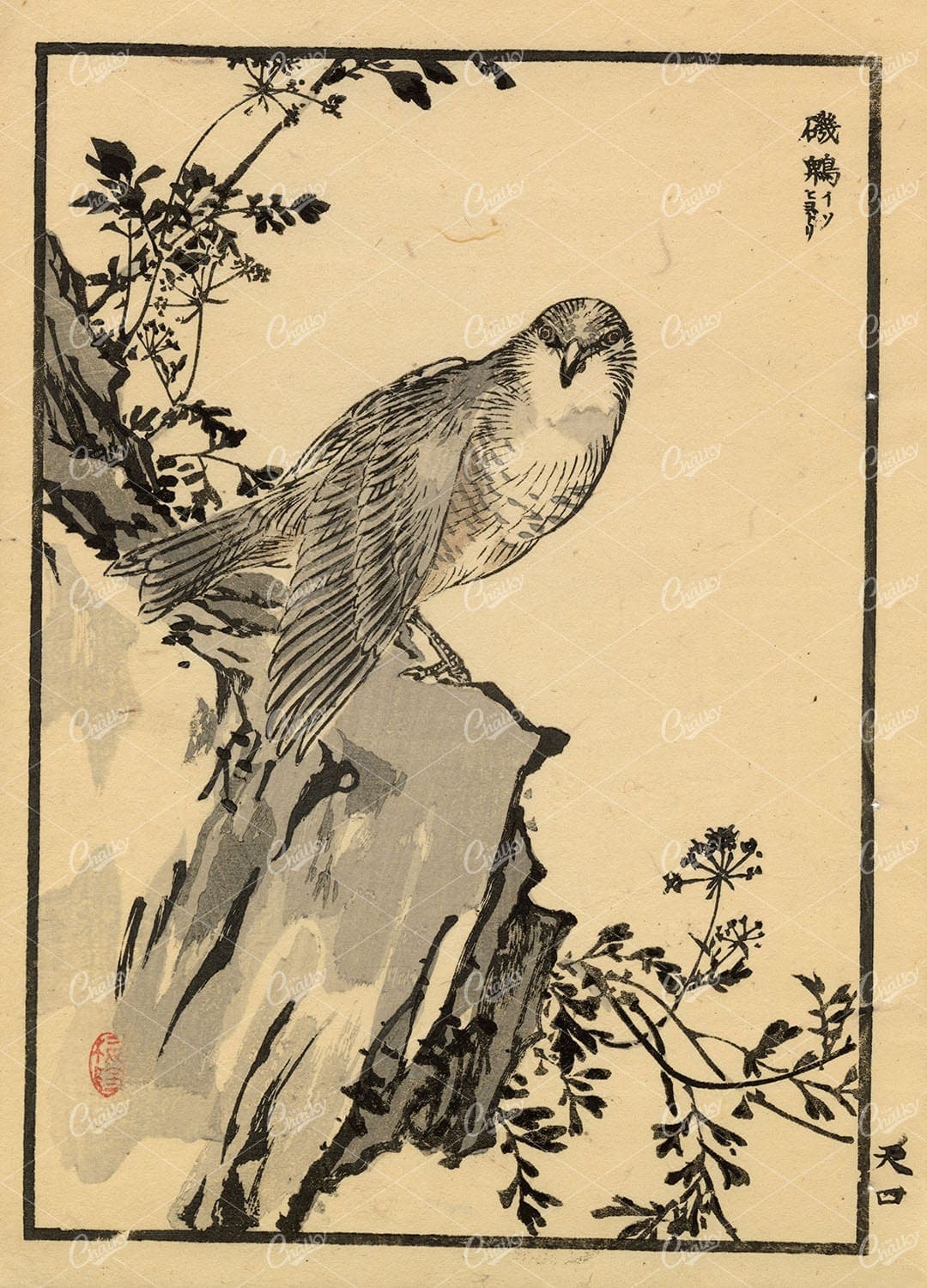

ANTIQUE Original Kono Bairei Woodblock Japanese Print 1881 Bird
You’re looking at a beautiful piece of Japanese woodblock art from our collection of original 1881 prints by noted artist, Kono Bairei; Created for one of his best-known publications ‘one hundred birds’. Most of the bird species throughout this collection were native to Japan, with a few domesticated and some imported cage birds. Bairei was born and lived in Kyoto. He was apprenticed to the Maruyama printer Nakajima Raiso at the age of eight. He was a pupil of Shijo artist Shiokawa Bunrin and followed the Nanga school tradition. He established the Kyoto Prefectural School of Painting before opening his own studio to students and retiring from teaching.
- License Info
- Resolution: 5754 x 7990 300dpi
- Year of Print: 1881
- Artist: Kono Bairei
From this collection


EAST HAMPTON from the Belfry Church – Swallows, Windmill – 1874 Print
You're looking at a beautifully detailed engraved illustration from the 'Picturesque America' series. Published by D. Appleton and Company of New York in 1872 and 1874 and edited by the romantic poet and journalist William Cullen Bryant. The "Picturesque America; or, The Land We Live In. A Delineation by Pen and Pencil of the Mountains, Rivers, Lakes, Forests, Water-falls, Shores, Cañons, Valleys, Cities, and Other Picturesque Features of Our Country. With Illustrations on Steel and Wood, by Eminent American Artists" series was published and delivered as a subscription; semi-monthly parts were sent out to subscribers. Once complete, the subscription would be bound into volumes. The stately, bound two volume set was proudly displayed in parlors of subscriber homes as a show of status. Engravers included Robert Hinshelwood (1812-1885), Edward Paxman Brandard (1819-1898), Samuel Valentine Hunt (1803-1893), William Wellstood (1819-1900), William Chapin (1802-1888), Henry Bryan Hall (1808-1884).
- License Info
- Resolution: 8230 x 11109 300dpi
- Year of Print: 1874
- Artist: D. Appleton
From this collection
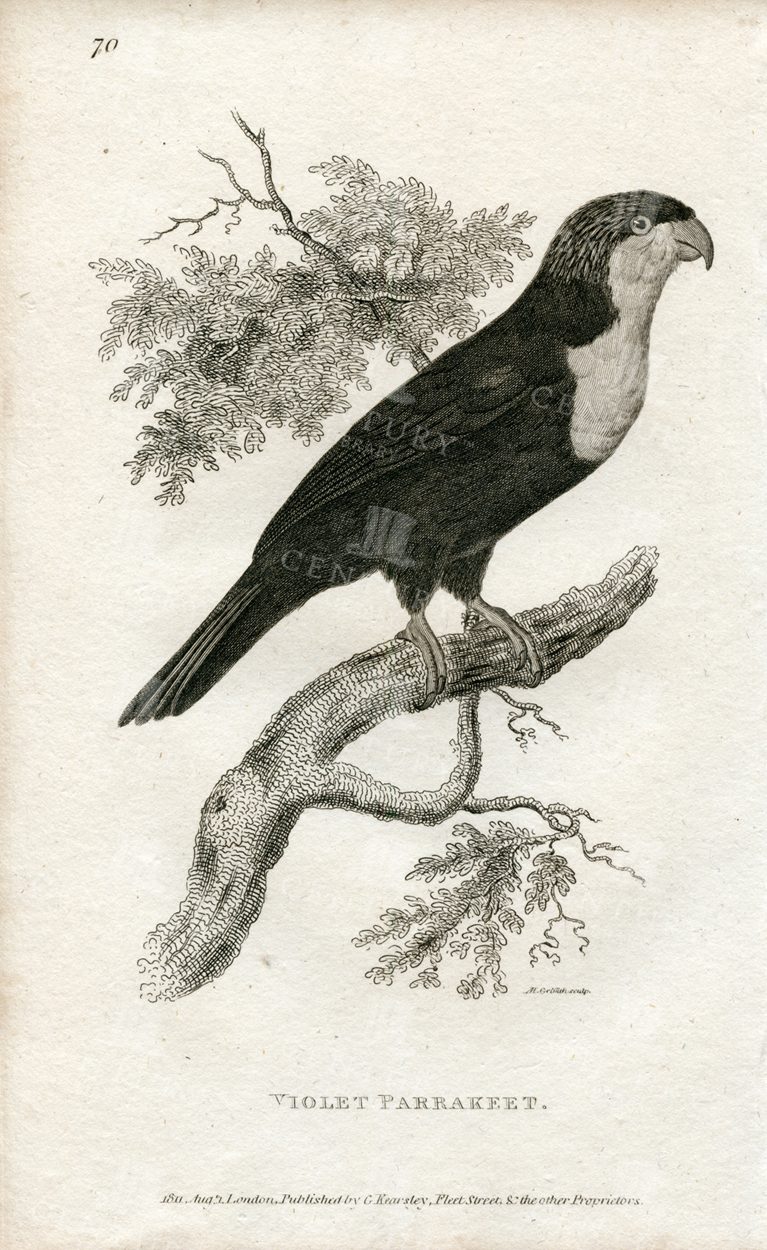

VIOLET PARAKEET -Vintage Zoology Engraving – 1812 Antique Print
- License Info
- Resolution: 4627px x 7548px
- Year of Print: 1812
- Artist: George Shaw Engravings by Mrs Griffith
Related Images


ANTIQUE Original Kono Bairei Woodblock Japanese Print 1881 Bird Butterfly
You’re looking at a beautiful piece of Japanese woodblock art from our collection of original 1881 prints by noted artist, Kono Bairei; Created for one of his best-known publications ‘one hundred birds’. Most of the bird species throughout this collection were native to Japan, with a few domesticated and some imported cage birds. Bairei was born and lived in Kyoto. He was apprenticed to the Maruyama printer Nakajima Raiso at the age of eight. He was a pupil of Shijo artist Shiokawa Bunrin and followed the Nanga school tradition. He established the Kyoto Prefectural School of Painting before opening his own studio to students and retiring from teaching.
- License Info
- Resolution: 5781 x 8004 300dpi
- Year of Print: 1881
- Artist: Kono Bairei
From this collection
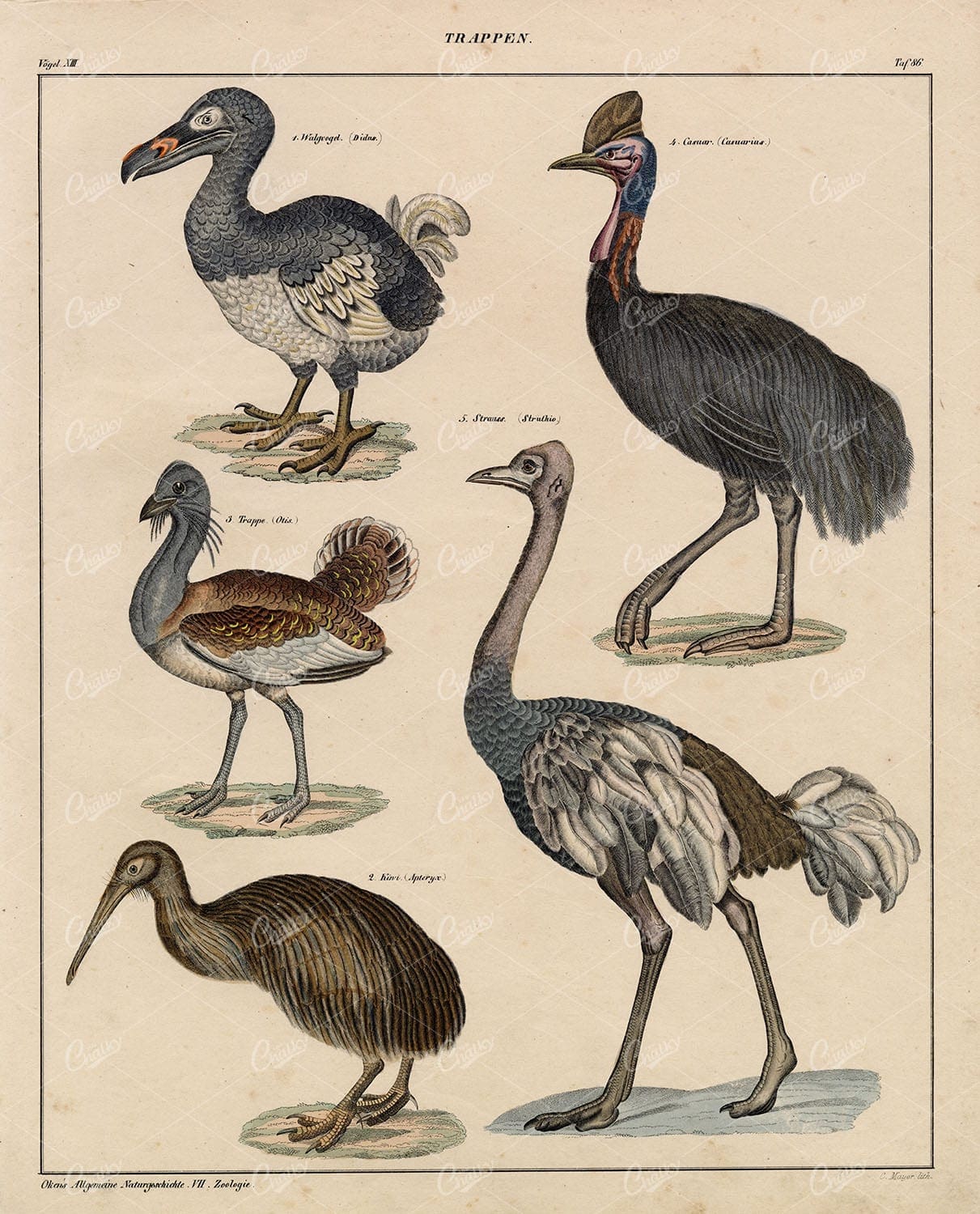

BIRDS – Dodo, Cassowaries, Kiwi, Great Bustard – Antique Lithograph
Original Colour Vintage Print from Lorenz Okenfuss' 'Oken's Naturgeschichte' (Allgemeine Naturgeschichte für alle Stände), with illustrations by Johann Susemihl (1767-1847), and published in Stuttgart by Hoffman between 1839 and 1841. Lorenz Oken (1 August 1779 - 11 August 1851) was a German naturalist, botanist, biologist, and ornithologist. Oken was born Lorenz Okenfuss (German: Okenfuß) in Bohlsbach (now part of Offenburg), Ortenau, Baden, and studied natural history and medicine at the universities of Freiburg and Würzburg. He went on to the University of Göttingen, where he became a Privatdozent (unsalaried lecturer), and shortened his name to Oken. As Lorenz Oken, he published a small work entitled Grundriss der Naturphilosophie, der Theorie der Sinne, mit der darauf gegründeten Classification der Thiere (1802). This was the first of a series of works which established him as a leader of the movement of "Naturphilosophie" in Germany.
- License Info
- Resolution: 9300 x 11600 300dpi
- Year of Print: 1836
- Artist: Lorenz Oken
From this collection
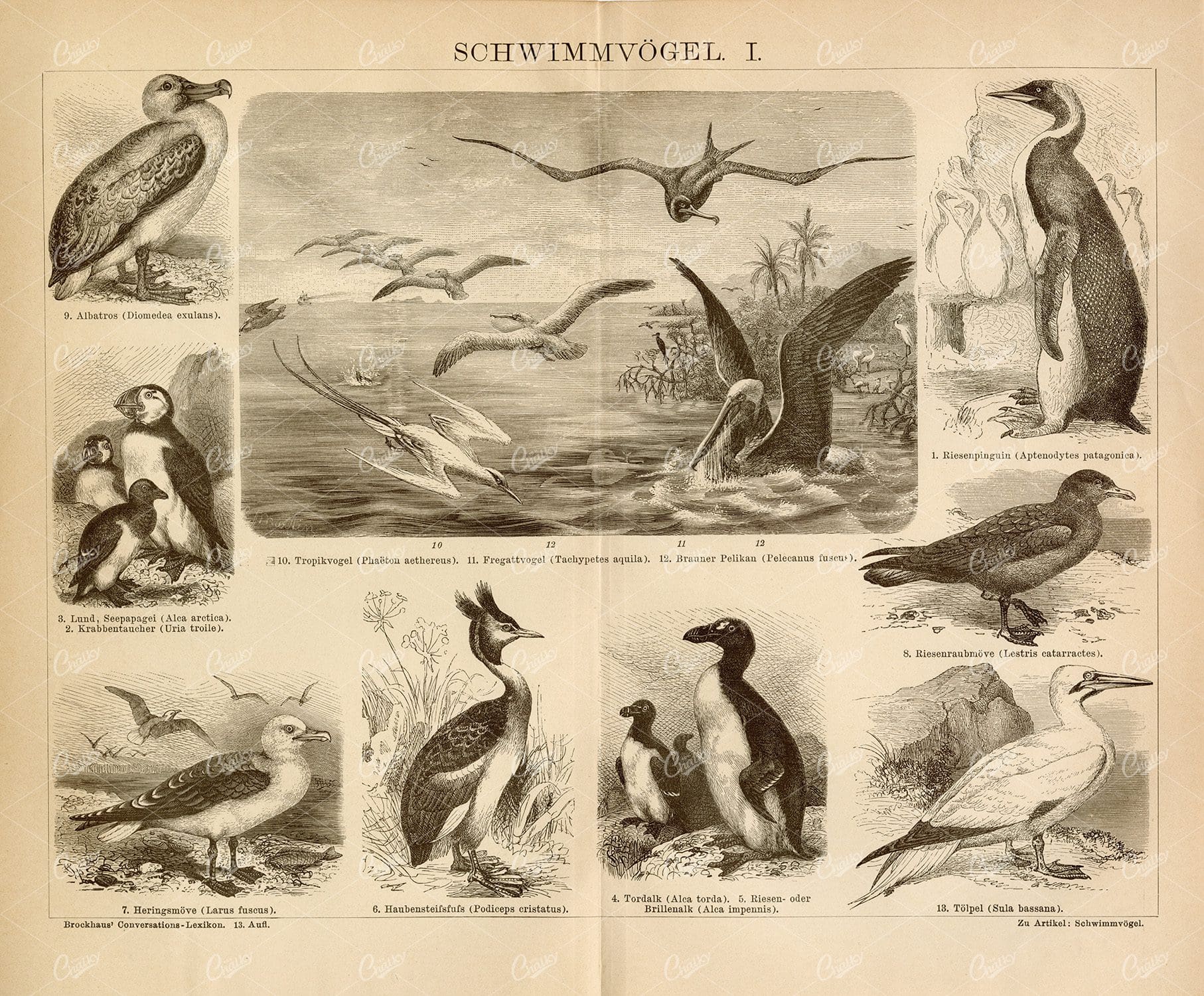

1882 VINTAGE Print – Swimming Birds – Albatros, Brown Pelicanus
- License Info
- Resolution: 10532px x 8711px
- Year of Print: 1882
Related Images


ANTIQUE Illustration – Nest of Saw-beaked Hummingbird – 1877 Engraving
- License Info
- Resolution: 4920 x 7488 300dpi
- Year of Print: 1877
- Artist: Unknown
Related Images


BEAUTIFUL Colour Vintage Print 1904 – East African Balearic Crane
- License Info
- Resolution: 5359px x 7877px
- Year of Print: 1904
- Artist: J. R. Ainsworth Davis
Related Images
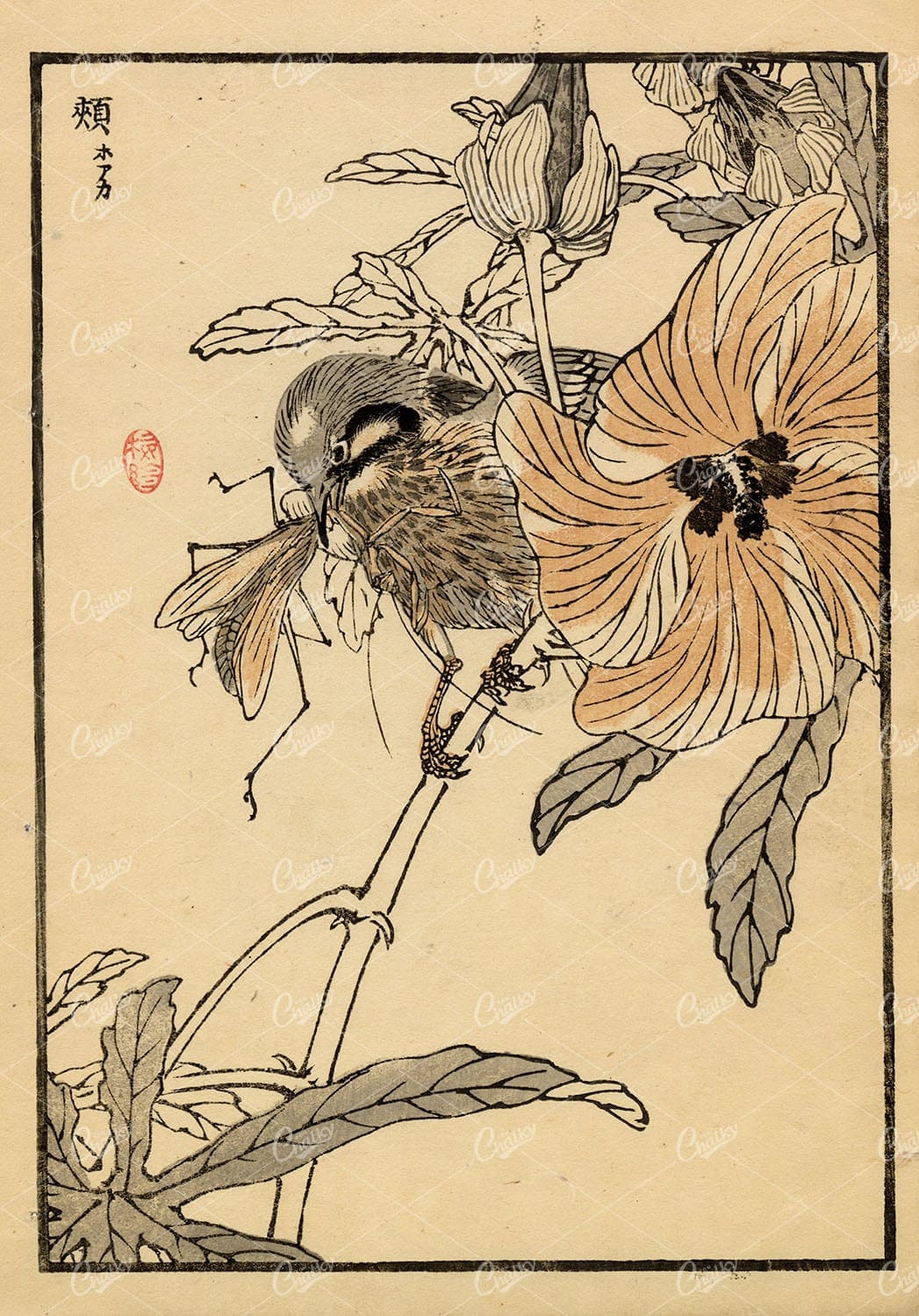

ANTIQUE Original Kono Bairei Woodblock Asian Art Print 1881 Bird Eating
You’re looking at a beautiful piece of Japanese woodblock art from our collection of original 1881 prints by noted artist, Kono Bairei; Created for one of his best-known publications ‘one hundred birds’. Most of the bird species throughout this collection were native to Japan, with a few domesticated and some imported cage birds. Bairei was born and lived in Kyoto. He was apprenticed to the Maruyama printer Nakajima Raiso at the age of eight. He was a pupil of Shijo artist Shiokawa Bunrin and followed the Nanga school tradition. He established the Kyoto Prefectural School of Painting before opening his own studio to students and retiring from teaching.
- License Info
- Resolution: 5621 x 8056 300dpi
- Year of Print: 1881
- Artist: Kono Bairei
From this collection
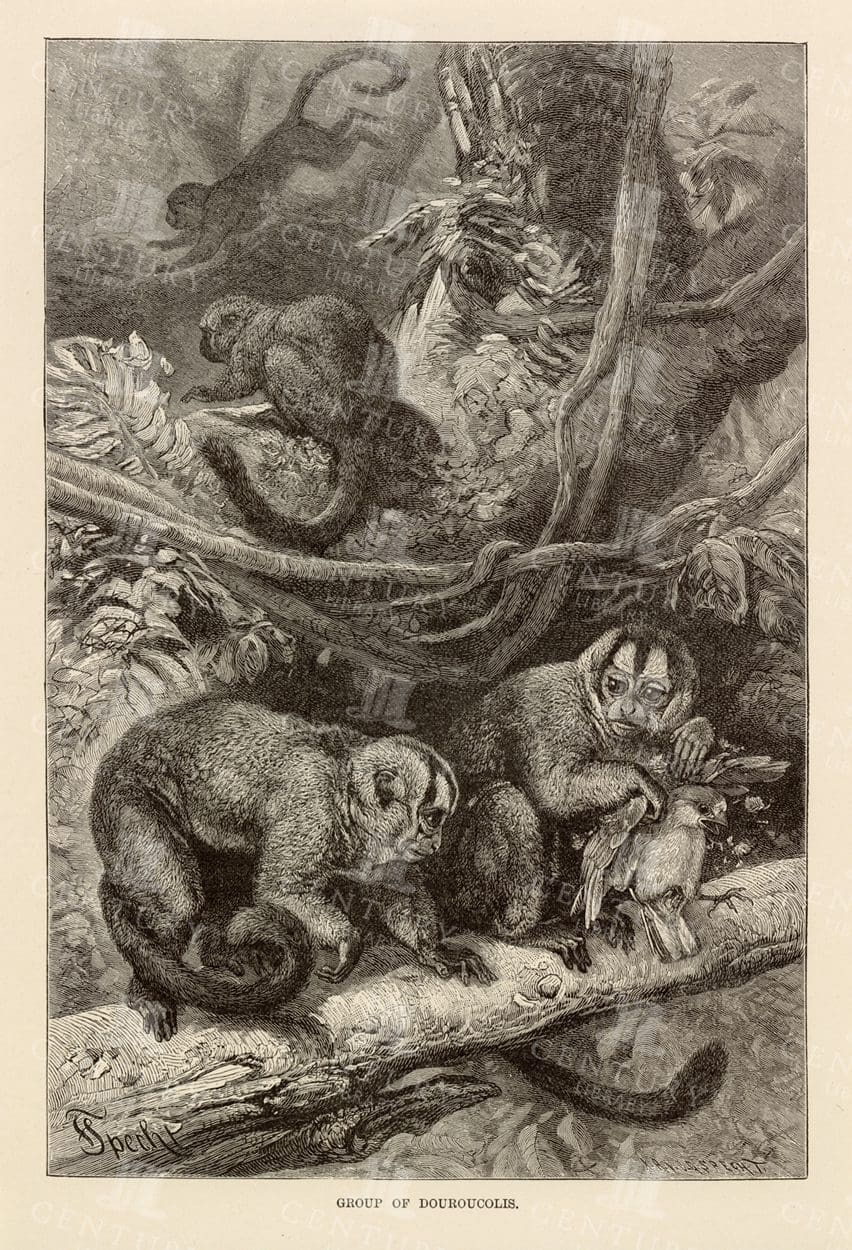

VINTAGE 1904 Natural History Print – Group of Douroucoulis
- License Info
- Resolution: 5474px x 8032px
- Year of Print: 1904
- Artist: J. R. Ainsworth Davis
Related Images


ANTIQUE Original Kono Bairei Woodblock Japanese Print 1881 Bird on Branch
You’re looking at a beautiful piece of Japanese woodblock art from our collection of original 1881 prints by noted artist, Kono Bairei; Created for one of his best-known publications ‘one hundred birds’. Most of the bird species throughout this collection were native to Japan, with a few domesticated and some imported cage birds. Bairei was born and lived in Kyoto. He was apprenticed to the Maruyama printer Nakajima Raiso at the age of eight. He was a pupil of Shijo artist Shiokawa Bunrin and followed the Nanga school tradition. He established the Kyoto Prefectural School of Painting before opening his own studio to students and retiring from teaching.
- License Info
- Resolution: 5623 x 8088 300dpi
- Year of Print: 1881
- Artist: Kono Bairei
From this collection


EGGS – Variety of Bird Eggs – Oken’s Naturgeschichte Vintage Print
Original Colour Vintage Print from Lorenz Okenfuss' 'Oken's Naturgeschichte' (Allgemeine Naturgeschichte für alle Stände), with illustrations by Johann Susemihl (1767-1847), and published in Stuttgart by Hoffman between 1839 and 1841. Lorenz Oken (1 August 1779 - 11 August 1851) was a German naturalist, botanist, biologist, and ornithologist. Oken was born Lorenz Okenfuss (German: Okenfuß) in Bohlsbach (now part of Offenburg), Ortenau, Baden, and studied natural history and medicine at the universities of Freiburg and Würzburg. He went on to the University of Göttingen, where he became a Privatdozent (unsalaried lecturer), and shortened his name to Oken. As Lorenz Oken, he published a small work entitled Grundriss der Naturphilosophie, der Theorie der Sinne, mit der darauf gegründeten Classification der Thiere (1802). This was the first of a series of works which established him as a leader of the movement of "Naturphilosophie" in Germany.
- License Info
- Resolution: 9300 x 11600 300dpi
- Year of Print: 1836
- Artist: Lorenz Oken
From this collection


ANTIQUE Natural History Print – Albatross, Farter, Penguin, Gannet Birds
- License Info
- Resolution: 4505px x 7542px
- Year of Print: 1821
- Artist: Thomas Tegg
From this collection
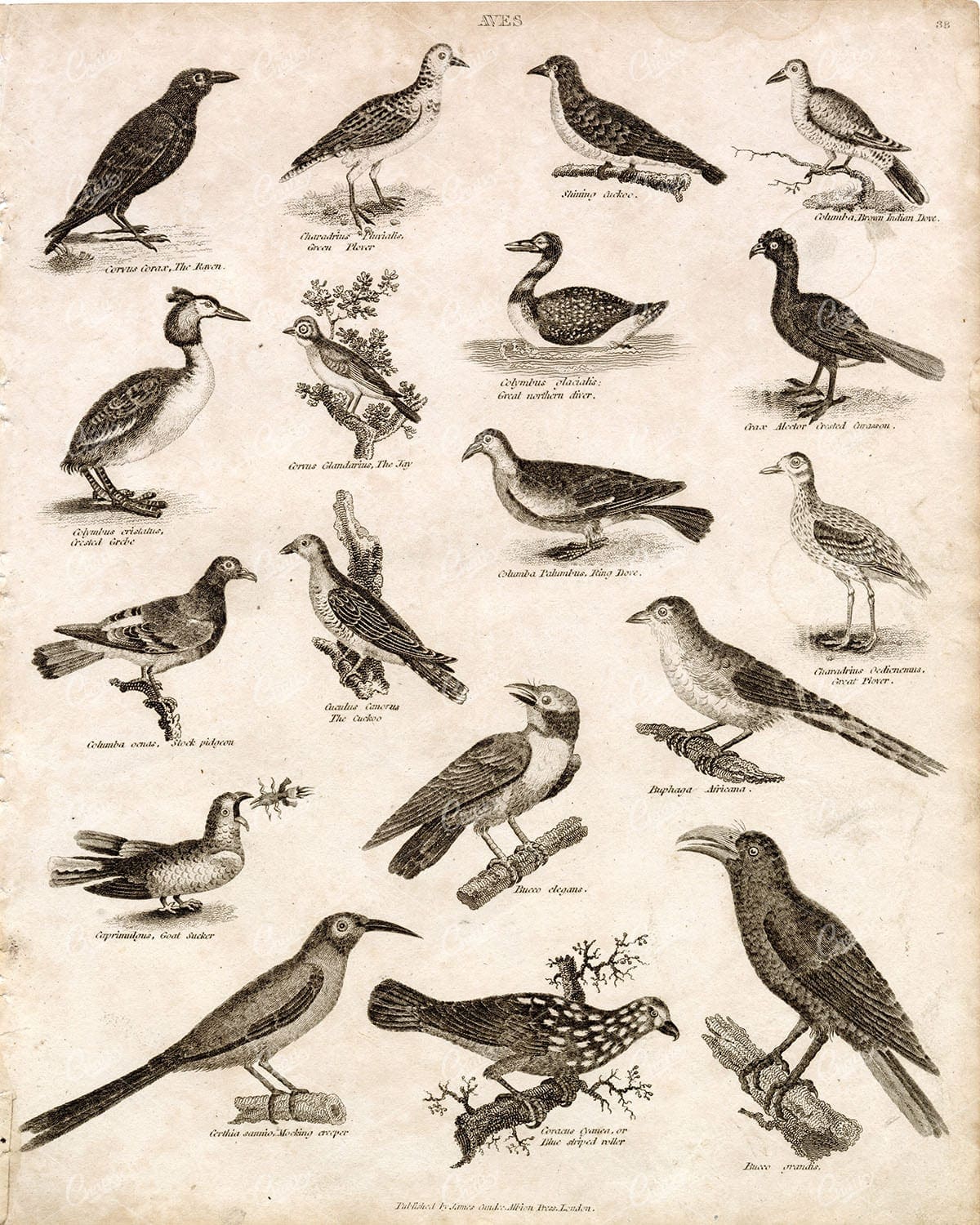

ANTIQUE Birds Print – Raven, Plover, Jay, Goat Sucker, Pidgeon, Dove 1800s
You're looking at an Original pre-1820's Antique Engraving from a rare copy of Abraham Rees' "The Cyclopaedia; or, UNIVERSAL DICTIONARY OF ARTS, SCIENCES, and LITERATURE" (Published 1820 by Longman, Hurst, Rees, Orme)
- License Info
- Resolution: 7400 x 9350 300dpi
- Year of Print: 1800s
- Artist: Abraham Rees
From this collection
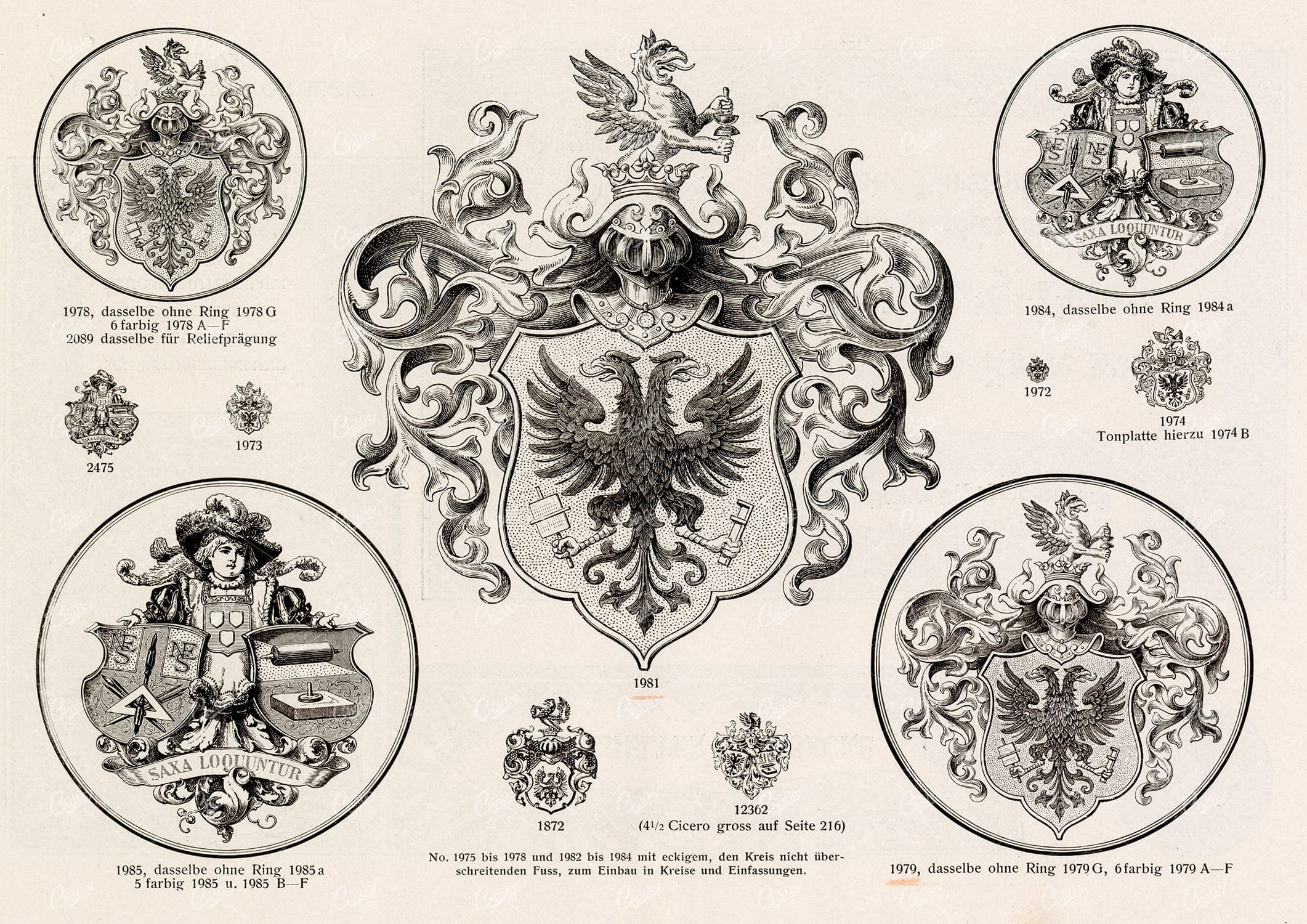

MISCELLANEOUS Selection of Vintage Design Elements – 1800s Antique Stock Artwork
The type foundry and print shop of old would create books, like the one this image was discovered within, to help customers and clients with their design choices. Naturally, these books were jam packed with useful illustrative elements that could be combined to create a final piece. Today, these books are extremely difficult to get a hold of. Especially those that were published in the late 1800s. They were not mainstream publications, they simply served as 'catalogs' and thus were only produced in small numbers. Fortunately, we were introduced to a collector who had precisely what we had been searching for for so long. After some costly negotiations, we're very excited to be able to share the wonderful gems within.
- License Info
- Resolution: 7717 x 5455
- Year of Print: Late 1800s
- Artist: Schelter & Giesecke Type Foundry
From this collection
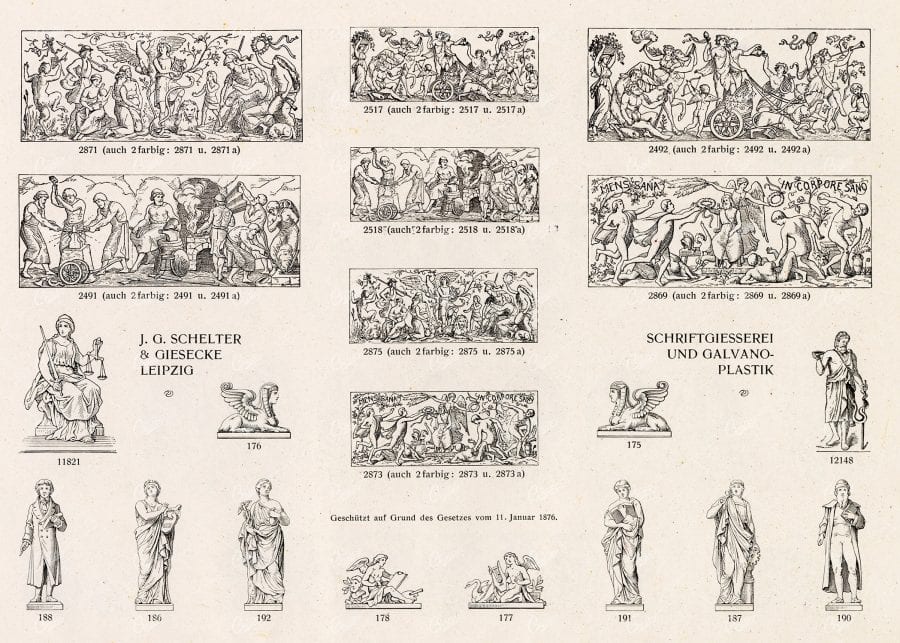
Support the Library
Our supporters and members help us continue collecting and restoring these wonderful pieces of art for the modern creator
Unlock Everything and Become a Member!
While a lot of the library is available for free, some is kept behind closed dusty doors only to be accessed by our lovely members.

